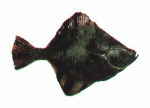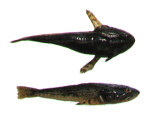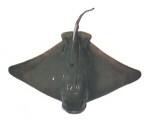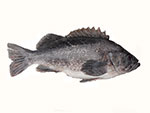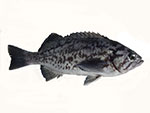Striped Bass

Family: Serranidae (Sea Basses) or Percichthyidae
Genus and Species: Roccus saxatilis*
* Also known as Morone saxatilis
Description: The body of the striped bass is elongate and slightly compressed. The head is a narrow, cone-shape, and the mouth is large. The color is greenish above, silvery on the sides, and white below. There are six to nine horizontal blackish stripes on the side. In southern California, the much smaller salema occasionally is mistaken for young striped bass; the salema, however, has orange-brown stripes and larger eyes than those of striped bass.
Range: Striped bass were brought to California from New Jersey in 1879. They now are found from northern Baja California to Barkley Sound, British Columbia. In California, they most commonly are found in the Sacramento-San Joaquin Delta, San Francisco Bay and adjacent ocean areas.
Natural History: Examination of stomach contents show that shrimp and anchovies are most important during the summer and fall while a variety of small fishes are eaten during the winter. Females usually mature at 5 years of age when about 24 inches long and many males mature at age 2 when about 11 inches long. A 5 pound fish may spawn as many as 25,000 eggs in one season; while a 12 pounder will spawn 1,250,000 eggs. A 75 pound striper produces as many as 10,000,000 eggs. Striped bass are believed to spawn only in fresh water in which there is an appreciable current. In California, they spawn from March to July with a peak in April and May.
Fishing Information: By far the largest part of the striped bass catch is made in San Francisco Bay and the Delta. Good fishing occurs during late summer, but is best in the fall. Stripers occur along the coast only during late spring and summer at which time surf fishermen get a chance at them. A variety of artificial lures and chunks or strips of standard bait fish will attract stripers. The beaches immediately adjacent to the Golden Gate are generally the best coastal spots, but occasional good runs are encountered as far south as Monterey and as far north as Bodega Bay. In San Francisco Bay, trolling with live bait is popular, with common catches under 10 pounds.
Other Common Names: striper, streaked bass, squidhound, rock bass.
Largest Recorded: 4 feet; 90 pounds (California); however, in the Atlantic Ocean to 6 feet and 125 pounds.
Habitat: Bay Environment
Giant Sea Bass – NO FISHING ALLOWED

Family: Serranidae (Sea Basses) or Percichthyidae
Genus and Species: Stereolepis gigas
Description: The body of the adult giant sea bass is elongate, with dorsal spines that fit into a groove on the back. The head is robust, and mouth is large with teeth in the back. Giant sea bass are usually reddish brown to dark brown in color on all but their stomachs and, at times, many have dark spots on their sides. Perch-like in appearance, juvenile giant sea bass differ radically from adults and are often mistaken for a different fish. Coloring on juveniles is distinct with the body being sandy red with white and dark patches spread along the sides.
Range: Giant sea bass occur throughout the Gulf of California and from Cabo San Lucas, Baja California, to Humboldt Bay, California. In California, the appearance of this species north of Point Conception has been sporadic.
Natural History: Giant sea bass feed upon a wide variety of items. Small fish taken of this species off our coast contained mostly anchovies and white croakers. Pacific mackerel, jack mackerel, sheephead, ocean whitefish, sand bass, cancer crabs, and red crabs have all been found in the stomachs of large giant sea bass. By their very bulk they appear to be slow and cumbersome, yet they are capable of outswimming and catching a bonito in a short chase. Giant sea bass apparently do not mature until they are 11 to 13 years old. A fish of this age will weigh between 50 and 60 pounds. The ovaries of a 320 pound female weighed 47 pounds and contained an estimated 60 million eggs. This fish was ready to spawn and the larger eggs were about 0.04 inch in diameter. The main spawning season for giant sea bass occurs during July, August, and September.
Fishing Information: There is a moratorium on the take of giant sea bass in California. All fish must be returned alive to the water.
Other Common Names: black sea bass, jewfish, giant bass.
Largest Recorded: over 7 feet; 563.5 pounds (Anacapa Island, 1968).
Habitat: Deep Rocky Environment
Kelp Bass

Family: Serranidae (Sea Basses)
Genus and Species: Paralabrax clathratus
Description: The body of the kelp bass is elongate and compressed. The head is relatively elongate, compressed and has a pointed snout. The mouth is large. The color is brown to olive green, with light blotches, becoming lighter below. Kelp bass can be easily distinguished from sand bass by the fact that the third, fourth and fifth dorsal spines of kelp bass are about the same length; while in sand bass, the third dorsal spine is much longer than the fourth and fifth spines.
Range: Kelp bass occur from Magdalena Bay, Baja California, to the Columbia River, Washington. They are taken regularly from Point Conception south to central Baja California in depths down to 150 feet.
Natural History: Small shrimp-like crustaceans are very important in the diet of kelp bass of all ages. However, with increase in size there is a corresponding increase in the amount of fish eaten. Anchovies, small surfperch, and other small fishes are part of the diet. By the time kelp bass are 10.5 inches long and 5 years of age, nearly all are capable of spawning. The spawning season usually extends from May through September with a peak during July. As with most members of the bass family, growth is slow and a 9 year old fish is only about 16.5 inches long.
Fishing Information: Kelp bass are caught primarily with live anchovies fished at or near the surface in and around kelp beds. They may be taken throughout the water column by trolling near kelp beds with live or dead bait. Numerous anglers also catch them on cast plugs, spoons, lures, and jigs. These anglers obtain their best catches with a yellowish, bronze, or white colored jig. In localities where kelp bass are not spoiled by offerings of live bait, they willingly accept hooks baited with strips or chunks of anchovy, mackerel or squid. Kelp bass are noted for their fighting qualities regardless of the type of bait or lure used.
Other Common Names: calico bass, bull bass, kelp salmon, cabrilla.
Largest Recorded: 28.5 inches; 14.5 pounds.
Habitat: Shallow Rocky Environment
Barred Sand Bass

Family: Serranidae (Sea Basses)
Genus and Species: Paralabrax nebulifer
Description: The body of the barred sand bass is rather elongate and compressed. The mouth is large and the lower jaw protrudes slightly. The color is gray white on the back, white on the belly and there are dark vertical bars on the sides. Barred sand bass can be easily distinguished from kelp bass by the height of the third dorsal spine. In barred sand bass, this spine is the longest of the dorsal spines, while in the kelp bass, the third, fourth and fifth dorsal spines are of about equal length. Barred sand bass can be distinguished from spotted sand bass by the lack of spots on the body.
Range: Barred sand bass occur from Magdalena Bay, Baja California, to Santa Cruz, California. This species occurs from shallow water to depths of 600 feet; however, most fish are taken in 60 to 90 feet of water.
Natural History: The barred sand bass diet includes crabs, octopus, squid, and small fishes. The adults aggregate and spawn during warmer months. The eggs are free floating. The striped young appear in southern California nearshore areas and eelgrass beds during fall and winter.
Fishing Information: Most barred sand bass landed in California are taken between May and October. They are fished in three main areas: Horseshoe Kelp to Newport Beach, Dana Point to Oceanside and the Silver Strand off San Diego. The best method for catching barred sand bass is to search a sandy area with an echosounder until a school is located. The boat then can be anchored and fishing commenced with live anchovies. Barred sand bass will usually “build” or gather under the boat when chummed so it pays to wait for awhile before moving.
Other Common Names: sand bass, sandy, ground bass, sugar bass, kelp bass, California sandbass, rock bass.
Largest Recorded: 26 inches. Largest taken off California by a recreational angler: 13.3 pounds.
Habitat: Shallow Sandy Environment
Spotted Sand Bass

Family: Serranidae (Sea Basses)
Genus and Species: Paralabrax maculatofasciatus
Description: The body of the spotted sand bass is moderately elongate and compressed. The mouth is large and the jaw protruding only slightly. The color is olive brown with round black spots on the body, head and fins. Spotted sand bass can be easily distinguished from kelp bass by the height of the third dorsal spine. In spotted sand bass and barred sand bass it is the longest of the dorsal spines, while in the kelp bass the third, fourth and fifth spines are of about equal length. Spotted sand bass differ from barred sand bass by the presence of spots that cover the entire body.
Range: Spotted sand bass occur from Mazatlan, Mexico, to Monterey, California. Spotted sand bass are confined to large bays in southern California. Because of this, they are taken less frequently than kelp or barred sand bass. They may be taken in the open ocean but this generally occurs only when drifting through the kelp.
Natural History: Spotted sand bass eat primarily crustaceans, and small fishes; nevertheless, they do consume many other organisms that occur in their habitat. Spawning occurs during May and June.
Fishing Information: Most fishing for spotted sand bass takes place from March to November, with peak catches occurring during the spawning season (May and June). Most fish caught are between 12 and 13 inches long and taken at depths up to 200 feet. Spotted sand bass tend to aggregate around underwater structures such as rocks or pilings. Live anchovies fished around these structures should allow a catch of spotted sand bass, but lures such as spotted or plastic leadheads or “bay feathers” can be effective if correctly worked around suitable habitat.
Other Common Names: sand bass, bay bass, spotty.
Largest Recorded: 23 inches; 6.7 pounds.
Habitat: Bay Environment
California Marine Sportfish Identification: Flatfishes
Last Updated October 17, 2013
Note: Please consult current fishing regulations for species presented in this booklet. To view information on safe fishing eating guidelines, please visit the OEHHA website.
California Halibut | Longfin Sanddab | Pacific Halibut | Pacific Sanddab | Petrale Sole | Starry Flounder
California Halibut
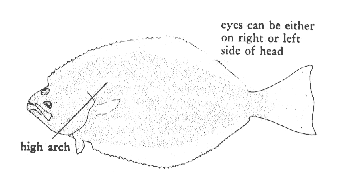
Family: Bothidae (Left-eyed flounders)
Genus and Species:Paralichthys californicus
Description: The body of the California halibut is oblong and compressed. The head is small and the mouth large. Although a member of the left-eyed flounder family, about 40 percent of California halibut have their eyes on the right side. The color is dark brown to black on the eyed side and white on the blind side. Their numerous teeth, very large mouth and a high arch in the middle of the “top” side above the pectoral fin make them easily distinguishable from other flatfish.
Range: California halibut occur from Magdalena Bay, Baja California, to the Quillayute River, British Columbia. A separate population occurs in the upper Gulf of California.
Natural History: California halibut feed almost exclusively upon anchovies and similar small fishes. At times they are observed jumping clear of the water as they make passes at anchovy schools near the surface. Males first mature when 2 or 3 years of age, but females do not mature until 4 or 5. A 5 year old fish may be anywhere from 11 to 17 inches long. Spawning takes place in relatively shallow water during the months of April through July.
Fishing Information: California halibut are pursued by anglers throughout the year, but the best landings usually occur in the spring. In central and northern California fishing is best in summer and early fall. At that time California halibut move into shallow water to spawn. Drifting for halibut is the most successful fishing method with anglers using live anchovies, queenfish, white croakers, shiner perch or Pacific mackerel as bait. Artificial lures work well at times although they are not always effective. California halibut are found over sandy bottoms.
Other Common Names: flatty, fly swatter (small), barn door (large), alabato, Monterey halibut, chicken halibut, southern halibut.
Largest Recorded: 5 feet; 72 pounds.
Habitat: Shallow Sandy Environment
Pacific Sanddab
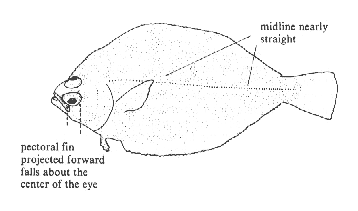
Family: Bothidae (Left-eyed flounders)
Genus and Species:Citharichthys sordidus
Description: The body of the Pacific sanddab is oblong and compressed. The head is deep; the eyes are on the left-side and are large. The color is light brown mottled with yellow and orange on the eyed side and white on the blind side. Although three kinds of sanddabs live in the waters off California, only two are commonly used for food the Pacific and longfin sanddabs. The third, the speckled sanddab, is so small (only about 5 inches) that it is only important to the diet of other fishes. The Pacific sanddab can best be distinguished from the longfin sanddab by the length of the pectoral fin on the eyed side. It is always shorter than the head of the Pacific sanddab and longer than the head of the longfin. Sanddabs are always left “handed” (eyes on the left) and can be distinguished from all other left “handed” flatfish by having a midline that is nearly straight for its entire length.
Range: Pacific sanddabs occur from Cape San Lucas, Baja California, to the Bering Sea. They seldom inhabit water that is shallower than 30 feet or deeper than 1,800 feet. They are most abundant at depths of 120 to 300 feet.
Natural History: Pacific sanddabs eat a wide variety of food. In addition to such items as small fishes, squid, octopus, they eat an assortment of eggs, luminescent sea squirts, shrimp, crabs, and marine worms. During the peak of the spawning season, which is July, August and September, the females spawn numerous eggs. These fish probably spawn more than once during a season.
Fishing Information: If the depth is correct and the bottom suitable, it is extremely difficult to keep sanddabs off the hook. Sportfishing for sanddabs entails the use of small hooks. Small pieces of squid or octopus are good baits because they are tough and stay on the hook, but pieces of fish work equally well.
Other Common Names: sand dab, soft flounder, sole, mottled sanddab, megrim.
Largest Recorded: 16 inches; 2 pounds.
Habitat: Deep Sandy Environment
Longfin Sanddab
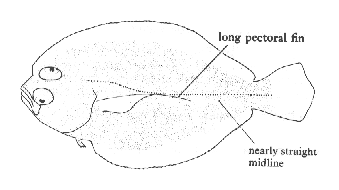
Family: Bothidae (Left-eyed flounders)
Genus and Species:Citharichthys xanthostigma
Description: The body of the longfin sanddab is oblong and compressed. The head is deep; the eyes are large and on the left side. The mouth is large. The color is uniform dark brown with rust orange or white speckles, and the pectoral fin is black on the eyed side; the blind side is white. The longfin sanddab can best be distinguished from the Pacific sanddab by the length of the pectoral fin on the eyed side. It is always shorter than the head on the Pacific sanddab and longer than the head on the longfin. Sanddabs are always left “handed” and can be distinguished from all other left “handed” flatfish by having a mid-line that is nearly straight for its entire length.
Range: Longfin sanddabs occur from Costa Rica to Monterey, California. These flatfish are usually on sandy, muddy type sea bottoms from 8 to 660 feet.
Natural History: Longfin sanddabs eat a wide variety of food. In addition to such items as small fishes, squid, and octopus, they eat an assortment of eggs, luminescent sea squirts, shrimp, crabs, and marine worms. Females are larger than males and normally mature when 3 years old and about 7.5 inches long. They produce numerous eggs and each fish probably spawns more than once a season. The peak of the spawning season is July, August and September.
Fishing Information: If the depth is correct and the bottom type is right, it is extremely difficult to keep sanddabs off the hook. Sportfishing for sanddabs entails the use of small hooks. Small pieces of squid or octopus are best because they are tough and stay on the hook best, but fish works equally well as a bait.
Other Common Names: sanddab, soft flounder, Catalina sanddab.
Largest Recorded: 10 inches
Habitat: Deep Sandy Environment
Pacific Halibut
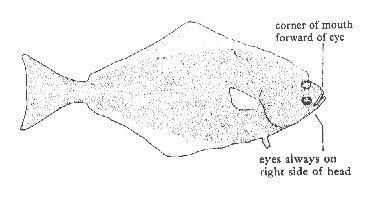
Family: Pleuronectidae (Right-eyed flounders)
Genus and Species:Hippoglossus stenolepis
Description: The body of the Pacific halibut is elongate, rather slender, diamond shaped and compressed. The head is elongate and the mouth is large. Both eyes are on the right side of the body. The color of the body is dark brown to black with fine mottling on the eyed side and white on blind side. The Pacific halibut can be distinguished from the California halibut by looking at the end of the jaw. In the Pacific halibut, it extends to the front edge of the eye, while in the California halibut it extends beyond the eye.
Range: Pacific halibut occur from Punto Camolu, Baja California to Bering Sea and east to the Sea of Japan, at depths from 20 to 3,600 feet. In California, however, most are in nearshore areas from Fort Bragg northward, with the largest numbers being taken by anglers offshore north of California. They are rare south of San Francisco.
Natural History: The diet of the Pacific halibut includes fishes, crabs, clams, squid and other invertebrates. Females become mature at 8 to 16 years of age (average 12); however, males mature earlier. Spawning takes place along the Pacific Coast from December through March. A large female of 140 pounds may produce as many as 2,700,000 eggs. The eggs and young drift casually with the currents gradually rising toward the surface as development proceeds. When first hatched, the young swim upright; however, they soon start to turn to their left side and the left eye migrates to the right side. By early spring, the transformation is complete and the young settle to the bottom in shallow waters.
Fishing Information: Recreational anglers have caught Pacific halibut up to 346 pounds, but California anglers would be hard pressed to find a Pacific halibut that large. The fish are typically caught on crab, shrimp, squid, and other invertebrates.
Other Common Names: alabato, northern halibut, right halibut, genuine halibut, real halibut.
Largest Recorded: 8.75 feet; 507 pounds. Largest taken by a recreational angler in Alaska: 459 pounds.
Habitat: Deep Sandy Environment
Starry Flounder
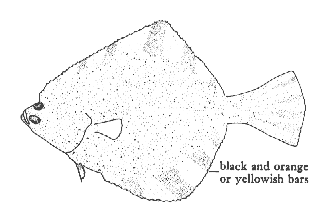
Family: Pleuronectidae (Right-eyed flounders)
Genus and Species:Platichthys stellatus
Description: The body of the starry flounder is broad, relatively short, somewhat diamond shaped and compressed. The head is relatively short and the eyes and mouth are small, the lower jaw slightly projecting. While a member of the right-eyed flounder family; the majority of starry flounders are left-eyed. The color is dark brown on the eyed side with alternating white to orange and black bars on the dorsal and anal fins; white on the blind side. Its name comes from the rough, star-like scales on the eyed-side.
Range: Starry flounders occur from Santa Barbara, California, to Arctic Alaska and the Sea of Japan. They occur over sand, mud and gravel bottoms in coastal ocean waters, bays, sloughs and even fresh water. Starry flounders are found from depths of a few inches to more than 900 feet.
Natural History: Small starry flounders eat mostly worms and small crustaceans. As they grow they eat progressively more crabs, clams, sand dollars and brittle stars. Large individuals also eat some fishes, among them sardines, sanddabs and surfperch. Females grow faster and attain larger sizes than do males. Males spawn at the end of their second year when they are about 14.5 inches long, and females in their third year at approximately 16.25 inches. The spawning season extends from November through February with greatest activity in December and January. Studies in California indicate that spawning occurs in water shallower than 25 fathoms. Like other flatfishes, the young are born with an eye on each side of the head. By the time they reach about 0.5 inches in length, both eyes are on the same side and they resemble their parents in all respects.
Fishing Information: Starry flounders are one of the most numerous fishes of central and northern California backwaters, particularly San Francisco Bay. They accept a variety of baits, including chunks of sardine, clams, shrimp, squid, and worms.
Other Common Names: rough jacket, great flounders, grindstone, California flounder, emery flounder, sand paper flounder.
Largest Recorded: 3 feet; 20 pounds.
Habitat: Shallow Sandy Environment
Petrale Sole
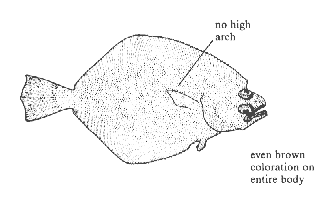
Family: Pleuronectidae (Right-eyed flounders)
Genus and Species:Eopsetta jordani
Description: The body of the petrale sole is elongate, moderately slender and compressed. The head is deep, and the mouth is large. The eyes are large and on the right side. The color is uniform dark to light brown with dusky blotches on the dorsal and anal fins on the eyed side and white on the blind side. Petrale sole are often confused with California halibut because of their similar color and large mouths. However, petrale sole have an even, brown coloration and do not have a high arch in the lateral line. Length: Up to 29.5 inches.
Range: Petrale sole occur from Cedros Island, Baja California, to the Bering Sea. They are found at depths from intertidal to 1,815 feet.
Natural History: The diet of the petrale sole includes crabs, shrimp, and fishes such as anchovies, hake, small rockfish and other flatfish.
Fishing Information: Although this flatfish is not often sought by recreational anglers, its large size and excellent eating qualities make it a good sportfish. Probably the entire sport catch for this species is taken incidentally by anglers on rockfish trips aboard commercial passenger fishing vessels. These anglers fishing in waters from 100 to 300 feet deep catch petrale sole on the sand surrounding rocky reefs.
Other Common Names: sole, round-nosed sole, Jordan’s founder, California sole, brill.
Largest Recorded: 27.5 inches; no weight.
Habitat: Deep Sandy Environment
California Marine Sportfish Identification: Other Fishes
Last Updated October 17, 2013
Note: Please consult current fishing regulations for species presented in this booklet. To view information on safe fishing eating guidelines, please visit the OEHHA website.
Cabezon | California Sheephead | California Barracuda | California Lizardfish | California Grunion | Chinook Salmon | Coho Salmon | Giant Kelpfish | Green Sturgeon | Halfmoon | Jack Mackerel | Jacksmelt | Kelp Greenling | Lingcod | Opaleye | Pacific Hake | Pacific Tomcod | Pacific Staghorn Sculpin | Sablefish | Sargo | Striped Marlin | Swordfish | White Sturgeon | Yellowtail
Green Sturgeon – NO FISHING ALLOWED
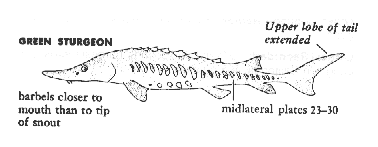
Family: Acipenseridae (Sturgeons)
Genus and Species:Acipenser medirostris
Description: The body of the green sturgeon is long, roughly cylindrical and has five rows of bony plates on its back. The snout is narrow, long, and cone-shaped, and more or less depressed below the level of the forehead. The mouth is toothless, protruding, and sucker-like. Four fleshy projections, or barbels, extend from the underside of the snout. The color is olive green above, whitish below, with olive stripes on the sides. The green sturgeon can be distinguished by its olive green color, the number of bony plates along the side of the body (mid lateral plates; 23 to 30), a very pointed snout, and the barbels are closer to the mouth than to the tip of the snout.
Range: Ensenada, Baja California, to the Bering Sea and Japan. The green sturgeon is commonly found in brackish water (part saltwater, part freshwater).
Natural History: The green sturgeon sifts muds and silts for food and feeds upon small invertebrates and fishes. Since it has no teeth, it must swallow its food whole. The green sturgeon is anadromous, spending its adult life in the ocean but ascending coastal streams in the winter where it remains to spawn the following summer. This species appears to reach sexual maturity in 10 or 15 years and may live to be over 100 years old. Adults migrate from salt water into fresh water beginning in late February and stays to spawn in the summer months. Males reach maturity at about 14 years of age and females at 16 years of age. Green sturgeon have been reported to reach ages of 60-70 years.
Fishing Information:TheSouthern Distinct Population Segment (DPS) of green sturgeon includes populations originating from coastal watersheds south of the Eel River, was listed as federally threatened in 2006, and in 2007 the recreational fishery was closed coastwide. The green sturgeon is listed as a state Species of Special Concern.
Other Common Names: none.
Largest Recorded: 7 feet; 350 pounds.
Habitat: Bay Environment
White Sturgeon
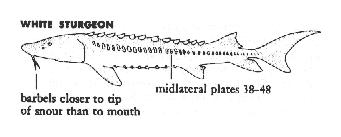
Family: Acipenseridae (Sturgeons)
Genus and Species:Acipenser transmontanus
Description: The body of the white sturgeon is long, roughly cylindrical, and has five rows of bony plates on its back. The snout is bluntly rounded and more or less depressed below the level of the forehead. The mouth is toothless, protruding, and sucker-like. Four fleshy projections, or barbels, extend from the underside of the snout. The fish is overall gray in color. The white sturgeon can be distinguished from the green sturgeon by its overall grey color, 38 to 48 bony plates along the side, a round snout, and the barbels are closer to the tip of the snout than to the mouth.
Range: This species occurs from Ensenada, Baja California, to the Gulf of Alaska. The white sturgeon is the largest fish found in North American freshwaters. The white sturgeon is anadromous, and spends more of its time in the brackish (part salt, part fresh water) waters of bays than in the open ocean. Most anadromous fish spend their adult life in the ocean or brackish water, and spawn up freshwater streams.
Natural History: White sturgeon are bottom feeders and their diet consists predominantly of clams, grass shrimp, crabs and herring roe. All can be used as good baits to catch fish that are most commonly under 300 pounds. Rocks, twigs and other odd things have been found in their stomachs and a white sturgeon caught in the Snake River had eaten half a bushel of onions that it had found floating in the river. This species is long lived and may live to be over 100 years old.
Fishing Information: A good food fish, the white sturgeon in California has been taken commercially in the past for its eggs (caviar). A white sturgeon report card is required for all anglers fishing for or taking white sturgeon.
Other Common Names: Sacramento sturgeon, Oregon sturgeon.
Largest Recorded: 12 feet; 1,285 pounds. Largest recreational caught in California: 468 pounds.
Habitat: Bay Environment
Coho (Silver) Salmon – NO FISHING ALLOWED
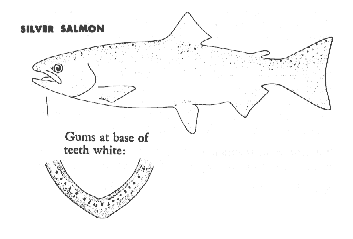
Family: Salmonidae (Salmons)
Genus and Species:Oncorhynchus kisutch
Description: The body of the coho salmon is elongate and somewhat compressed. The head is conical. This species is dark metallic blue or blue green above, becoming silvery on the sides and belly. There are spots on the back. The main distinguishing feature between the coho and chinook salmon is the color of the gums at the base of the teeth. Chinook salmon have a blackish lining while coho has a white lining. Cohos also have black spots only on the upper part of the tail fin, whereas chinook tail fins are completely covered with black spots.
Range: Coho salmon occur from Chamalu Bay, Baja California, to the Bering Sea and Japan.
Natural History: Cohos, as all salmon, are anadromous and spawn in fresh water. At spawning time the males turn dusky green above and on their head, bright red on their sides and blackish below. The females turn a pinkish red on their side after they enter fresh water. Coho salmon enter streams, move upstream, and spawn from September through March. The bulk of spawning takes place from November through January. Adult males enter streams when they are either 2 or 3 years old, but adult females do not return to spawn until 3 years old. Almost all female coho salmon will spawn at age 3. All coho salmon, whether male or female, spend their first year in the stream or river in which they hatch. All adults die after spawning. Generally speaking, the larger the female the greater the number of eggs produced; however, numerous counts have been made that indicate most females will spawn from 1,500 to 3,500 eggs. The average number produced per female appears to be about 2,500.
Fishing Information: Coho salmon has been listed as a state and federal endangered species, and the recreational fishery is closed. To avoid coho when fishing for Chinook salmon fish near shore and use larger lures.
Other Common Names: silver salmon, silversides, hookbill.
Largest Recorded: 38.5 inches; 31 pounds.
Habitat: Pelagic Environment
Chinook (King) Salmon
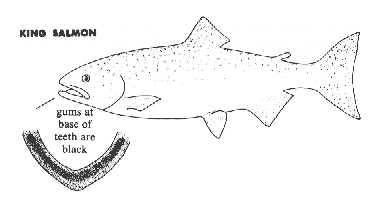
Family: Salmonidae (Salmons)
Genus and Species:Oncorhynchus tshawytscha
Description: The body of the chinook salmon is elongate and somewhat compressed. The head is conical. The color is bluish to dark gray above, becoming silvery on the sides and belly. There are black spots on the back and on both lobes of the tail. While five species of salmon occur along the Pacific Coast, over 99% of all salmon caught in the ocean off California are either chinook or cohos. Chinook and coho salmon can be distinguished by the color of the lining of the gums at the base of the teeth. In chinook salmon, this lining is blackish, while in cohos it is white.
Range: Chinook salmon occur from San Diego, California, to the Bering Sea and Japan. Generally, the fishery begins off San Luis Obispo County, California, and continues north.
Natural History: Chinooks and all salmon are anadromous that is, they spend part of their life in the ocean and then enter fresh water to spawn. The adults spawn principally in large river systems, primarily from the Sacramento River system north. At spawning time, male chinooks turn very dark and usually have blotchy, dull red splotches on the sides and develops a hooked nose. Most all chinook spawn when either 3 or 4 years of age but some, predominately males, will spawn at age 2. These precocious males are called jacks, chubs or grilse. Some rivers have large chinooks that do not spawn until 5 or 6 years old. Sacramento River female chinook salmon produce an average of 6,000 eggs each. This, however, is an unusually high number since female chinook salmon from other river systems normally average only 3,500 to 4,500 eggs each.
Fishing Information: In the ocean, chinook salmon are fished principally by trolling dead bait or artificial lures. Occasionally, live bait will be used while anchored or drift-fishing. Chinook salmon normally stay well beneath the surface of the ocean, usually 40 to 250 feet or more and a heavy weight or downrigger is necessary to keep trolled bait at the desired depth.
Other Common Names: king salmon, Sacramento River salmon, spring salmon, black mouth, Columbia River salmon, tyee.
Largest Recorded: 4 feet 10 inches; 126.5 pounds. Largest taken off California by a recreational angler: 65 pounds, 4 ounces.
Habitat: Pelagic Environment
California Lizardfish

Family: Synodontidae (Lizardfishes)
Genus and Species:Synodus lucioceps
Description: The California lizardfish has an elongate cylindrical body with a head and mouth which are lizard-like in appearance. The body is a uniform brown on the back and sides shading to tan or white on the belly. Because of its elongated body and mouth full of sharp teeth, California lizardfish are occasionally mistaken for the California barracuda. The barracuda, however, is silvery rather than brown and has two dorsal fins of approximately equal size with a wide space between them. The lizardfish has only a single dorsal fin with a tiny fleshy fin behind it.
Range: The California lizardfish occurs from Guaymus, Mexico to Cape Beal, British Columbia, Canada, but is not common north of Point Conception, California. This species generally occurs over sandy bottoms in shallow water ranging from 30 to 180 feet, but has been taken at depths up to 750 feet.
Natural History: The California lizardfish spend most of their time sitting on the bottom with the body at a slight angle, propped up in the front end by the ventral fins. This inactivity ends rapidly when small fishes or squid swim into the area and the fish dart upward to grab one, usually swallowing the prey in one gulp. This species is believed to begin spawning during the summer months when adult fish have been observed to congregate on sandy patches. Spawning peaks in the fall. Young lizardfish, less than 3 inches long, are nearly transparent, elongate, scaleless, with a row of large black spots under the skin of the belly.
Fishing Information: The California lizardfish, while not sought by most anglers, is taken incidentally in fairly large numbers by anglers fishing for other shallow water bottomfishes like halibut. California lizardfish can be caught on a wide variety of cut baits fished on the bottom.
Other Common Names: candlefish, lizardfish.
Largest Recorded: 25.17 inches; no weight recorded; however, it is reported to reach 4 pounds.
Habitat: Shallow Sandy Environment
Pacific Whiting (Pacific Hake)
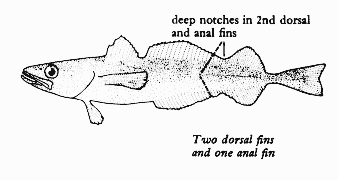
Family: Merlucciidae* (Hakes)
Genus and Species:Merluccius productus
* Gadidae (American Fisheries Society)
Description: The body of the Pacific whiting is elongate, slender, and moderately compressed. The head is elongate and the mouth large. The color is gray to dusky brown, with brassy overtones and black speckles on the back. The elongated shape, notched second dorsal and anal fin, and the coloration separate Pacific whiting from other fish in this group.
Range: The Pacific whiting occurs in the Gulf of California (isolated population) and from Magdalena Bay, Baja California, to Alaska and along the Asiatic coast. It is found to depths exceeding 2,900 feet.
Natural History: The diet of this species includes euphausiids (small crustaceans), shrimp and pelagic fishes. Pacific whiting spawn in the winter, beginning at 3-4 years of age, off southern California and Baja California, Mexico. After spawning the adults migrate northward to Oregon, Washington and Canada and return to their spawning areas in the fall.
Fishing Information: Pacific whiting are most commonly caught incidentally by anglers seeking salmon or bottomfish. Considered a nuisance by many recreational anglers, they are generally discarded if caught. If kept and chilled immediately after capture, Pacific whiting have good food qualities. However, the flesh becomes soft and undesirable if not cared for properly. Pacific whiting may be caught with salmon or groundfish baits such as squid, herring or anchovy.
Other Common Names: Pacific hake, whitefish, haddock, butterfish, California hake, popeye, silver hake.
Largest Recorded: 3 feet; no weight recorded.
Habitat: Deep Sandy Environment
Pacific Tomcod
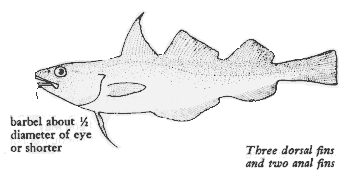
Family: Gadidae (Codfishes)
Genus and Species:Microgadus proximus
Description: The body of the Pacific tomcod is elongated, slender and moderately compressed. The head is elongate and there is a small fleshy projection, a barbel, on the lower jaw. The color is olive green above, creamy white below, and the fins have dusky tips. Three spineless dorsal fins and the small chin barbel separate the Pacific tomcod from any similar appearing fish, except its cousin, the Pacific cod. The Pacific cod has a barbel as long as the diameter of the eye while the Pacific tomcod has a barbel that is less than one half the diameter of the eye. The Pacific tomcod is a member of the true cod family. It is one of the smaller members of the group and is often confused with the white croaker. Again, the three spineless dorsal fins will distinguish this species from the others.
Range: The Pacific tomcod occurs from Point Sal, California, to Unalaska Island, Alaska, in near surface waters to depths of 908 feet, common to 500 feet.
Natural History: The diet of the Pacific tomcod includes anchovies, shrimp, and worms. A 10.3 inch female Pacific tomcod contained an estimated 1,200 eggs.
Fishing Information: Pacific tomcod are occasionally taken by recreational anglers in central and northern California. This is usually incidental to fishing for other species of fish. Since these are rather small fish, light line and small baited hooks are the proper gear. Small pieces of cut fish make good bait.
Other Common Names: tomcod, piciata, California tomcod.
Largest Recorded: 30 inches; no weight recorded.
Habitat: Shallow Sandy Environment
California Grunion
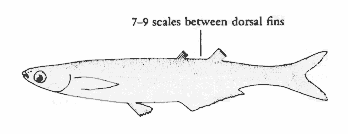
Family: Atherinopsidae (Silversides)
Genus and Species:Leuresthes tenuis
Description: The California grunion has an elongate body and head that are more or less compressed. The mouth is small. The scales are small, smooth and firm. This species is bluish green above, silvery below, and a bright silvery band tinged with blue and bordered above with violet extends the length of the body.
Range: The California grunion occurs from Magdalena Bay, Baja California, to San Francisco, California; however, the principal range is between Point Abreojos, Baja California, and Point Conception, California.
Natural History: The food habits are not well known; however, they do eat small crustaceans and fish eggs. The life span of California grunion is usually 3 years, with some individuals surviving 4 years. The most rapid growth takes place during the first year, at the end of which they are 5 inches long and capable of spawning. The spawning behavior of grunion is one of the more unusual of all marine fishes. They are the only California fish known to strand themselves on the beach to deposit their reproductive products in the moist sand. Females, accompanied by one to eight males, swim onto the beach, dig themselves into the sand up to their pectoral fins and lay their eggs. The males wrap themselves around the female and fertilize the eggs. With the next wave the fish return to the sea. During spawning activities, grunion may make a faint squeaking noise. Spawning takes place from early March through September, and then only for 3 or 4 nights following the full moon during the 1 to 4 hours immediately after high tide. Most females spawn from four to eight times a year producing up to 3,000 eggs every 2 weeks. California grunion are non-migratory, and are most often found in schools a short distance from shore in water 15 to 40 feet deep.
Fishing Information: California grunion may only be taken by hand. No appliances of any kind may be used, and no holes may be dug in the beach. The season is closed April and May. While the California grunion may not be taken during April or May, these are good months to observe spawning activities.
Other Common Names: smelt, little smelt, grunion, lease smelt.
Largest Recorded: 7.5 inches; no weight record; however, a 7 inch female full of eggs weighed less than 2 ounces.
Habitat: Surf Environment
Jacksmelt
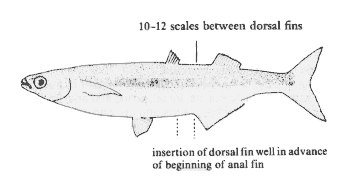
Family: Atherinopsidae (Silversides)
Genus and Species:Atherinopsis californiensis
Description: The body of the jacksmelt is elongate and somewhat compressed. The head is oblong and compressed, and the eyes and mouth are small. The color is greenish blue above, silver below, with a metallic stripe bordered with blue extending the length of the body. Jacksmelt, topsmelt, and California grunion are members of the silversides family and are not considered true smelt. These three species look very similar except for the location of the first dorsal fin. In the jacksmelt, the first dorsal fin is forward of a line drawn perpendicular to the vent (anus); in the topsmelt, it is just about over the vent and in the grunion, it is behind the vent.
Range: Jacksmelt occur from Santa Maria Bay, Mexico to Yaquina Bay, Oregon. Jacksmelt are found in California bays and ocean waters throughout the year. They are schooling fish which prefer shallow water less than 100 feet and are most common in 5 to 50 foot depths.
Natural History: Jacksmelt feed on small crustaceans. Jacksmelt that are 13 to 15 inches long are 8 or 9 years old. A 16 inch, 1 pound male was 11 years old. They will spawn first when 2 years old and about 6 inches long. The spawning season extends from October to March. Large masses of eggs, about the size of small BB’s, are attached to shallow water seaweeds by means of long filaments.
Fishing Information: Jacksmelt are one of the most common fishes taken by pier anglers, but are also caught in the surf. Sometimes a number of coiled up worms are found in the flesh. These are intermediate stages of spine headed worms, the adult of which are harmful to sharks, pelicans and other fish predators. The worms are harmless to humans when the fish is thoroughly cooked.
Other Common Names: silverside, horse smelt, blue smelt, California smelt.
Largest Recorded: 17.5 inches; no weight recorded; however, a jacksmelt 16 inches long weighed 1 pound.
Habitat: Bay Environment
Sablefish
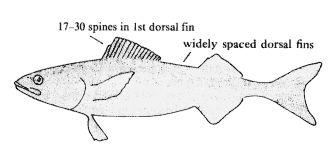
Family: Anoplopomatidae (Sablefishes)
Genus and Species:Anoplopoma fimbria
Description: The body of the sablefish is quite elongate, slightly compressed and tapering to the tail. The head is rather large and elongate. The sablefish is blackish gray on the back and sides, and gray to white below. Two well separated dorsal fins, very small teeth and the uniform coloration distinguishes this species.
Range: The sablefish occurs from Cedros Island, Baja California, to the Bering Sea and Japan; at depths ranging from the surface (juveniles) to 900 feet. They are usually taken in 80 to 600 feet of water; however, schools of small individuals occasionally enter shallow areas.
Natural History: The diet of sablefish include marine worms, crustaceans and small fishes. About 50 percent of the male sablefish are mature by the time they are 24 inches long and 5 years old, whereas 50 percent of the females first mature at 7 years, when they are 28 inches long. A 28 inch female weighing 6.5 pounds and 7 years old is capable of spawning about 100,000 eggs; while a 40 inch female that is 20 years old will contain approximately 1,000,000 eggs.
Fishing Information: During some years, young sablefish abound in inshore waters and can be caught in large numbers close to the surf zone. Most of the time, however, they live on the bottom in deeper water. There is a tendency for sablefish to move deeper during the winter spawning season; thus, the heaviest catches, which are made during summer months, are made in shallower water. Chunks of salted mackerel or fresh squid are both excellent baits. Sablefish are feeble fighters at best, but large fish have a weight advantage that makes hauling them from the depths a back breaking ordeal. The flesh is pure white and oily with a very mild flavor.
Other Common Names: butterfish, blackcod, coalfish, candlefish, skilfish, coal cod, bluecod, bluefish, deep sea trout, black candlefish, skill.
Largest Recorded: 40 inches, no weight recorded however the fish was estimated to be 80-92 years old. A sablefish 3 feet long weighed 40 pounds.
Habitat: Deep Sandy Environment
Lingcod
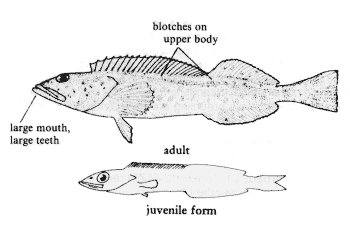
Family: Hexagrammidae (Greenlings)
Genus and Species:Ophiodon elongatus
Description: The body of the lingcod is elongate, tapering and only slightly compressed. The head is elongate and conical, the mouth is large with numerous large teeth. Lingcod are generally dark brown with lots of spots and blotches on the upper part of the body, but come in a variety of colors ranging from blue green to red brown.
Range: Lingcod occur between Point San Carlos, Baja California, and Kodiak Island, Alaska. They are not abundant south of Point Conception except in a few localities. They live at or near the bottom, generally in close association with rocky areas and kelp beds, especially where there is a strong tidal movement. They occur most abundantly at depths ranging to about 350 feet, but will often go into deeper water and have been caught as deep as 2,700 feet off southern California.
Natural History: Young lingcod feed primarily upon shrimp and other crustaceans until they are big enough to eat fish. Once started on fishes, it seems that any kind coming within reach is fair game. Male and female lingcod first mature when they are 3 years of age and about 23 inches in total length. Nearly all are mature at age 4 when they are nearly 26 inches long. Spawning usually takes place from December through March. The eggs are large (0.17 inch in diameter) and adhesive, sticking in large masses to rocky crevasses, generally on subtidal reefs. The male lingcod guards the eggs after fertilization until they hatch. A female 30 inches long may lay approximately 60,000 eggs; whereas, a 45 inch female may lay more than 500,000 in a single season.
Fishing Information: Lingcod are easily caught on standard rockfish rigs using anchovies or squid pieces. Larger baits such as live squid, mackerel or even small rockfishes often produce catches of very large lingcods. Large chromeplated metal jigs, large lead-head and rubber jigs, and lead-filled pipe jigs are also favorites of avid lingcod anglers. When sportfishing, live bait is more effective than dead bait and dead bait usually more than metal jigs. Whatever the bait, it seems more effective if jigged or bounced up and down along the bottom. Care should be taken when unhooking one of these toothy beasts. The lingcods teeth, as well as the gillrakers, are extremely sharp and can cause serious injury to the fingers of careless anglers. Unless you are wearing heavy gloves, NEVER put your fingers into the mouth or gill chamber of a lingcod. The safest way to pick up a lingcod is to place the thumb and first finger of one hand in the eye sockets and grab the tail with the other hand.
Other Common Names: ling, greenlinger, slinky linky, buffalo cod, cultus cod.
Largest Recorded: 52 inches; 56 pounds (California).
Habitat: Deep Rocky Environment
Kelp Greenling
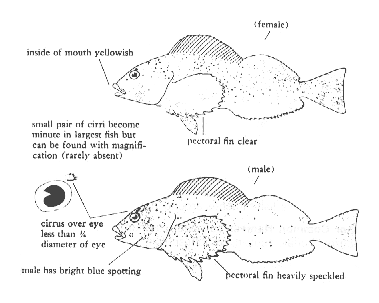
Family: Hexagrammidae (Greenlings)
Genus and Species:Hexagrammos decagrammus
Description: The body of the kelp greenling is elongate and somewhat compressed. The head is conical, blunt in profile, and the mouth is rather small. Male and female kelp greenling can be readily distinguished by their coloration. The forepart of the body of the male has numerous sky blue spots, each surrounded by a ring of rusty spots. The female is rather uniformly covered with round reddish brown spots. Certainly, the kelp greenling is one of the most boldly colored fishes found along our coast. The kelp greenling has small, unfringed flaps of skin (cirri) over the eyes and the mouth is yellowish inside; whereas, the rock greenling has a pair of large, fringed flaps of skin over the eyes and the inside of the mouth is bluish.
Range: Kelp greenling occur from La Jolla, California, to the Aleutian Islands, Alaska, but are quite rare south of Point Conception. They live in relatively shallow water along rocky coasts, around jetties and in kelp beds.
Natural History: Included in the kelp greenling’s diet are various seaworms, crustaceans, and small fishes. In California, spawning occurs between September and December. Females lay pale blue eggs masses on rocks where increased water circulation occurs. Egg masses average 4,000 eggs that may come from multiple females with females spawning at least 3 times per season. Like lingcod, male kelp greenlings are known to guard the nests.
Fishing Information: Kelp greenling is one of the major species in the rocky shore angler’s bag in central and northern California. The jetties at Eureka comprise the number one greenling “hole” in the state. They can be caught with hooks baited with cut pieces of fish, clams, mussels, shrimp, squid, worms and crab backs. Once hooked, the kelp greenling is difficult to land because of its habit of entangling the angler’s line about rocks, crevices or kelp.
Other Common Names: greenling sea trout, rock trout, spotted rock trout, kelp trout, kelp cod.
Largest Recorded: 3 pounds, no length recorded; however, a male 12 inches long weighed 1 pound.
Habitat: Shallow Rocky Environment
Pacific Staghorn Sculpin
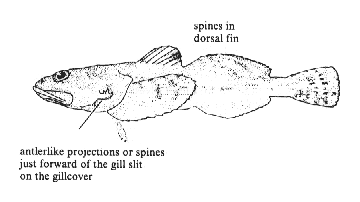
Family: Cottidae (Sculpins)
Genus and Species:Leptocottus armatus
Description: The body of the Pacific staghorn sculpin is elongate and scaleless. The head is long and depressed, and the mouth is large. The body coloration often blends with its environment and shows such varieties as greenish brown or gray above, and white to yellow below. The spinous dorsal fin has an obvious black spot and the pectoral fins are yellowish with dark cross bars. The most striking characteristic of this species is an antler-like spine located just forward of the gill cover.
Range: The Pacific staghorn sculpin occurs from San Quintin Bay, Baja California, to Chignik, Alaska. They frequent California’s bays, estuaries, lagoons, and shallow coastal waters, and are wide ranging from the intertidal zone to a depth of 906 feet.
Natural History: The diet of the Pacific staghorn sculpin includes crabs, shrimp, worms, mollusks, and many kinds of juvenile and adult fishes. These fish become sexually mature when 1 year old. Spawning takes place between October and April. The average sized female produces about 5,000 eggs in a season.
Fishing Information: The Pacific staghorn sculpin is attracted to a variety of baits, preferably small invertebrates. It is not highly prized as a food or sport fish. On the other hand, it is a popular bait fish for the San Francisco Bay Delta striped bass sport fishery. Caution is recommended when handling this species because the spines located on the gill cover can leave nasty cuts if the fish thrashes around in your hands.
Other Common Names: bullhead, staghorn sculpin, smooth cabezon, buffalo sculpin, smooth sculpin.
Largest Recorded: 12 inches (California), 18 inches (Canada); no weight recorded; however, a 10 inch fish weighed 0.5 pounds.
Habitat: Bay Environment
Cabezon
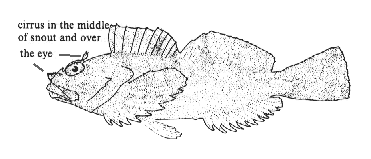
Family: Cottidae (Sculpins)
Genus and Species:Scorpaenichthys marmoratus
Description: The body of the cabezon is elongate and stout. The head is large, broad and the snout is bluntly rounded. The mouth is large. The color is usually dark brown, but a variety of colors ranging from blue green to reddish brown occur and there is much mottling. It looks somewhat like the lingcod, and sometimes has blue colored flesh. It is a member of the true sculpin family and it can best be distinguished from the similar looking lingcod by: the absence of scales on its body; and by the presence of a small flap of skin, a cirrus, over each eye and in the middle of the snout. The lining of its mouth is a pale to dark blue and it also lacks the large teeth of the lingcod.
Range: Cabezon occur from Point Abreojos, Baja California, to Sitka, Alaska. Cabezon are usually found on the bottom around rocky reefs and kelp beds in water less than 120 feet deep, although they are known to occur as deep as 300 feet.
Natural History: The cabezon’s diet is made up of about 50 percent crabs and 50 percent mollusks and fishes. Small abalones are swallowed whole and the shells are regurgitated after some digestion takes place. These shells are sometimes beautifully polished by the action of the acids. Male cabezon first mature when about 2 years old and 12 inches long, females when 2 1/2 years old and 16 inches long. Females grow faster and attain larger sizes than do males. Spawning takes place from November through March, peaking in January. The adults tend to congregate at nesting sites. The eggs are laid in large masses on cleared rocks. The individual nest is guarded by the male who will drive away any intruder. A 5 pound female will lay an average of 66,000 eggs and a 23 pound female, 152,000. The eggs and young are free floating, some having been taken more than 200 miles from shore. The young enter the tide pools and inshore areas during the spring when they are about 1.5 inches long. They then lose their silvery color and take on the pattern characteristic of adults.
Fishing Information: Cabezon are caught by rocky shore anglers in every suitable area throughout the state. Larger numbers are caught in the central and northern part of the state. They are one of the most sought-after rocky shore inhabitants. Suitable baits include mussels, clams, squid, shrimp, worms, cut or strip bait, and live bait when available. Here again is a bottom rock dweller that can be most difficult to land if allowed to retreat to the shelter of rocks or seaweeds after being hooked. Cabezon eggs are poisonous, so do not eat the roe. Consumption of cabezon roe has produced near fatal results in humans.
Other Common Names: bullhead, cab, cabby, bull cod, giant sculpin, scorpion, marble sculpin.
Largest Recorded: 39 inches; 25 pounds.
Habitat: Shallow Rocky Environment
Opaleye
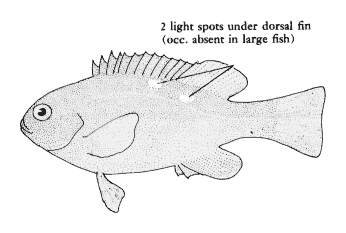
Family: Girellidae (Nibblers)
Genus and Species:Girella nigricans
Description: The body of the opaleye is oval and compressed. The snout is thick with an evenly rounded profile. The mouth is small. The color is dark olive green, and most have one or two white spots on each side of the back under the middle of the dorsal fin. The opaleye is California’s only representative of the nibbler family. Bright blue eyes and the heavy, olive green, perch-like body quickly distinguish it from any other species.
Range: Opaleye occur from Cape San Lucas, Mexico to Otter Rock, Oregon. Opaleyes are residents of rocky shorelines and kelp beds. Young ones, 1 or more inches long, live in tide pools, but they seek deeper water as they grow larger. The largest concentrations of opaleye are in 65 feet of water.
Natural History: Opaleye primarily eat marine algae with or without encrustations of organisms. Food items include feather boa kelp, giant kelp, sea lettuce, coralline algae, small tube dwelling worms, and red crabs. Ripe adults have been taken in April, May and June. They form dense schools in shallower water where spawning takes place. The eggs and larvae are free floating and at times are found a number of miles from shore. The juveniles form schools of up to two dozen individuals. When about 1 inch long they enter tidepools. As they grow they seek deeper and deeper water. They mature and spawn when about 8 or 9 inches long at an age of about 2 or 3 years.
Fishing Information: Few fish are harder to hook than the opaleye and few fish will put up more fight pound-for-pound. Long considered one of the better sport fish, they take mussels, sand crabs, pieces of fish or invertebrates on a hook. Since opaleye are primarily vegetarians, some anglers find it easier to catch them using various “mosses” for bait.
Other Common Names: green perch, black perch, blue-eyed perch, bluefish, Jack Benny, button-back.
Largest Recorded: 25.5 inches; 13.5 pounds.
Habitat: Shallow Rocky Environment
Halfmoon
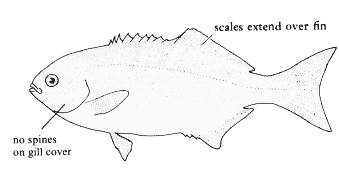
Family: Scorpididae* (Halfmoons)
Genus and Species:Medialuna californiensis
* Kyphosidae (American Fisheries Society)
Description: The body of the halfmoon is oval and compressed. The head is blunt and rounded and the mouth is small. The color is dark blue above, shading to blue gray on the sides and becoming white below. The tail is halfmoon shaped. The soft rays of the dorsal and anal fins are nearly hidden by a thick sheath of scales. The halfmoon most closely resembles the blue rockfish, but lacks the 5 spines on the front section of the gill cover, which are common to all rockfishes.
Range: Halfmoon occur from the Gulf of California to Vancouver Island, British Columbia . They are most common in southern California, particularly around the Channel Islands. Halfmoon occur over shallow rocky areas and in kelp beds. They have been observed as deep as 130 feet, but are most commonly taken by anglers from waters from 8 to 65 feet deep.
Natural History: Halfmoon feed on a variety of plant and animal matter such as red, green and brown algae, and sponges. In the turbulent areas of the rocky coasts they have been seen catching bits of upsurging seaweed. Spawning takes place during the summer months. Ripe adults are taken from July through October. The eggs and young are free floating and the young, like opaleye, are found some distance from shore. One inch halfmoon, are found at the outer edges of kelp beds. Only adults are commonly found in the inshore area. They reach maturity when about 7.5 inches long.
Fishing Information: Halfmoon are abundant throughout the year. They are scrappy and are good eating. Anglers, fishing from the rocks, have good success using mussels and shrimp; opaleye anglers occasionally catch them on moss bait. Anglers, fishing offshore, are most successful using fresh cut bait such as anchovy, sardine or squid.
Other Common Names: Catalina blue perch, blue bass, black perch.
Largest Recorded: 19 inches; 4.75 pounds.
Habitat: Shallow Rocky Environment
California Sheephead
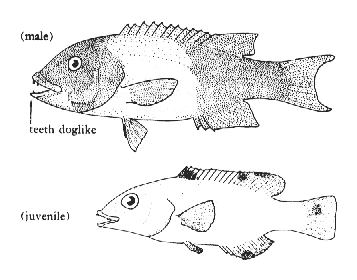
Family: Labridae (Wrasses)
Genus and Species:Semicossyphus pulcher
Description:The body of the California sheephead is elongate, robust, and compressed. This species is a “protogynous hermaphrodite” meaning it begins life as a female, then may become male later in life. Females mature at about 8 inches in length when they reach 3 to 6 years of age and may remain female for up to fifteen years. Timing of the transformation to males involves population sex ratio as well as size of available males and sometimes does not occur at all. This sex change is accompanied by a marked change in appearance. Female sheephead are a uniform pinkish red with a white lower jaw. As they age and become males, the head and rear third of the body turns black, the midsection of the body remains red and the lower jaw remains white. In all stages of their development, sheephead have unusually large dog-like teeth.
Range: California sheephead occur from Cabo San Lucas, Baja California, to Monterey Bay, California, with an isolated population in the Gulf of California. They are uncommon north of Point Conception. California sheephead are generally taken in rocky kelp areas near shore, in water from 20 to 100 feet deep, although they do occur in depths of 10-200 feet.
Natural History: Crabs, mussels, various sized snails, squid, sea urchins, sand dollars, and sea cucumbers are typical food items. The large canine-like teeth are used to pry food from rocks. A special plate in the throat crushes shells into small pieces for easy digestion. Occasionally, large adults have been observed out of the water in the intertidal hanging onto mussels after a wave has receded. Spawning takes place in early spring and summer. Young about 0.5 inch long occur in late May through late December and do not resemble the adult. They are brilliant red orange with two black spots on the dorsal fin and a black spot at base of tail fin. Pelvic and anal fins are black, trimmed in white. Occasional lemon yellow young are seen. The young live close to rocks at depths from 10 to well below 100 feet, particularly around beds of gorgonian corals (sea fans). When disturbed, they seek shelter in sea fans or among red seaweed. The following summer, juveniles are 3 to 4 inches long and have faded to dull pink. At 2 years they are 6 to 8 inches long, have lost all spots, and have a typical female color pattern.
Fishing Information: Sheephead will take a variety of live and cut baits, such as anchovy or squid, fished on the bottom. Those interested in trophy-sized sheephead may try a whole, live mackerel fished on the bottom. The angler who hooks a California sheephead is usually in for a strong, tugging battle. A battle that commonly ends in disaster when the “catch” runs through or around a kelp plant, or under the nearest rocky ledge.
Other Common Names: sheepie, goat, billygoats (large), red fish, humpy, fathead.
Largest Recorded: 36 inches; 36.25 pounds.
Habitat: Shallow Rocky Environment
California Barracuda
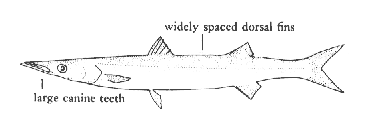
Family: Sphyraenidae (Barracudas)
Genus and Species:Sphyraena argentea
Description: The body of the California barracuda is very elongate and slender, and almost round. The mouth is large with canine-like teeth. It has a sharply pointed snout with a projecting lower jaw. The color is grayish black with a bluish tinge on the back becoming silvery or white on the sides and belly. The tail is yellowish and the dorsal fins are widely spaced.
Range: California barracuda occur from Cape San Lucas, Baja California, to Kodiak Island, Alaska. This species is found from the surface to depths of 60 feet, but is rare north of Point Conception, California.
Natural History: The California barracuda’s main forage is anchovies and other small fishes. At two years, almost all males and 75 percent of females are sexually mature. All are mature at three years of age. Full sexual maturity occurs in males at a length of 20 inches and in females at 22 inches. In a single spawning, a two-year-old female may produce 50,000 eggs, increasing to about 400,000 by age six. Individuals may spawn more than once during a spawning season. Off southern California, spawning takes place from April to September, peaking in June. Young barracuda up to 6 inches in length are usually found in shallow water close to shore.
Fishing Information: Most California barracuda are taken with live bait fished at or near the surface; however, they will take an assortment of trolled artificial lures. If you see a very large barracuda, in the 10 pound range, chances are it’s a female. Positive identification can be made because the female has a charcoal black edge on the pelvic and anal fins, whereas the male fins are edged in yellow or olive. Three pound barracuda are common, but generally they are large enough to put up a good fight. Caution should be taken when you land a barracuda to avoid their needle sharp teeth.
Other Common Names: barracuda, scoot, scooter, snake, barry, Pacific barracuda.
Largest Recorded: Reported to 5 feet, but recorded to 4 feet; 18.1 pounds.
Habitat: Pelagic Environment
Giant Kelpfish
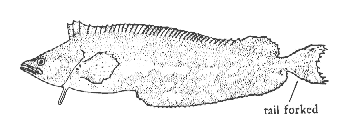
Family: Clinidae (Clinids)
Genus and Species:Heterostichus rostratus
Description: The body of the giant kelpfish is very elongate and compressed. The head is slender, compressed and pointed. The color may vary from light brown to green and purple with lighter areas of mottling. Giant kelpfish are easily separated from other family members because they are the only ones with forked tails; other members have rounded tails.
Range: Giant kelpfish range from Cabo San Lucas, Baja California, to British Columbia, and from surface waters down to 130 feet. Rocks covered with seaweed and kelp beds surrounding them provide the forage and habitat giant kelpfish desire.
Natural History: The diet of the giant kelpfish is predominantly small crustaceans, mollusks, and small fishes. Spawning occurs during March through July. During spawning, which occurs in a territory established by the male, the female releases her eggs on seaweed while she quivers with the male next to her, sometimes head to tail. Pink to greenish eggs are attached to the seaweed by entangling threads that extend from egg coverings. The male remains to guard the eggs. Transparent post larvae appear from April through August, usually in shallow water from 5 to 30 feet. Giant kelpfish school until approximately 2.5 inches long when they begin to assume adult colors and become solitary, living close among seaweeds.
Fishing Information: Anglers pursuing giant kelpfish should drift through giant kelp beds since the fish are closely associated with the plants. When fishing for this species, small hooks are recommended since the fish have small mouths. Small shrimp, juvenile clams and other small invertebrates are used as bait. Squid can also be used if cut into small pieces.
Other Common Names: kelpfish, eel, iodine fish, butterfish, kelp blenny.
Largest Recorded: 24 inches; no weight recorded; however, a 16.2 inch giant kelpfish weighed 1.2 pounds.
Habitat: Shallow Rocky Environment
Swordfish
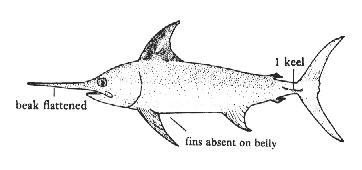
Family: Xiphiidae (Swordfishes)
Genus and Species:Xiphias gladius
Description: The body of the swordfish is elongate and somewhat compressed. The upper jaw is very much extended, forming a long, flat sword. The color is dark gray to black above becoming gray to yellowish below. Swordfish are readily distinguished from other billfish by their flattened bills, lack of fins on the belly, and the presence of only one keel (small projection) on the base of the tail adjoining the fish.
Range: Swordfish occur worldwide in temperate and tropical seas. Off southern California, they are most commonly encountered between the mainland and the Channel Islands.
Natural History: The diet of swordfish includes fishes such as small tuna, dorado, barracuda, flying fish, and mackerel as well as benthic species such as Pacific whiting and rockfish. Squid is also important when available. Swordfish do not spawn off the coast of California. Off Hawaii, spawning takes place from April through July with females producing up to 16 million eggs per season. The eggs take 2.5 days to hatch. Swordfish grow quickly during the first 6 years, with females reaching 74.5 inches, eye to fork of the tail (EFL) and males reach 68.8 inches EFL. Swordfish from the North Pacific Ocean have been aged to 12 years.
Fishing Information: Most recreational fishing for swordfish involves visually searching for a fish that is finning (presenting itself at the surface) and then maneuvering a baited hook in front of it. Live Pacific mackerel or dead squid are the preferred baits, although some anglers use live California barracuda. Once hooked, swordfish are strong and stubborn fighters with average encounters lasting more than 4 hours.
Other Common Names: broadbill, broadbill swordfish.
Largest Recorded: 15 feet; 503 pounds. Largest taken off California by a recreational angler: 452.5 pounds.
Habitat: Pelagic Environment
Striped Marlin
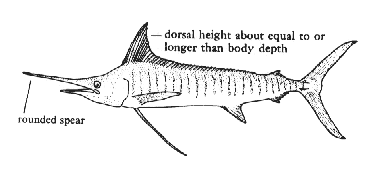
Family: Istiophoridae (Billfishes)
Genus and Species:Tetrapturus audax
Description: The body of the striped marlin is elongate and compressed. The upper jaw is much extended, forming a rounded spear. The color is dark blue above becoming silver below, with light blue bars or vertical spots on the sides. Of the billfishes that occur in California waters, the striped marlin is difficult to confuse with the others. Marlin have scales, fins on the belly, and a rounded spear which set them apart from swordfish which have no scales or ventral fins and have bills that are flat. Sailfish have an extremely high dorsal fin not found among the marlins, and shortnose spearfish do not have the long spear on the upper jaw nor the body weight of the marlin. The striped marlin normally develops conspicuous stripes along the sides of its body after death. This feature is unique to striped marlin.
Range: Striped marlin occur in tropical and warm temperature waters of the Indian and Pacific Oceans. On the west coast of the United States they range as far north as Oregon, but are most common south of Point Conception, California. They usually appear off California in July and remain until late October.
Natural History: The food of striped marlin is predominately fishes, squid, crabs and shrimp. The latter three make up lesser portions of the diet than do fish. The spear of the marlin is sometimes used both as a weapon for defense and as an aid in capturing food. Wooden boats frequently have been rammed by billfish, and in one instance the spear penetrated 18.5 inches of hardwood 14.5 inches of which was oak. When it uses its bill in capturing food, the striped marlin sometimes stuns its prey by slashing sideways with the spear rather than impaling its victim, as some believe.
Fishing Information: Most striped marlin are taken by trolling artificial lures in areas they are known to inhabit. Blind strikes are generally the rule, but one can occasionally tempt a “finner” or “sleeper” (marlin swimming along the surface) to strike if lures are trolled past the fish. Live bait also works well but requires more effort since the fish must usually be first spotted visually. Once a striped marlin is located, the angler should cast a bait in front of and past the fish so it can be reeled back towards the animal. Strikes usually result from properly presented live bait. Most striped marlin anglers prefer Pacific mackerel as bait. The best California fishing locality is in a belt of water which extends from the east end of Santa Catalina Island offshore to San Clemente Island and southward in the direction of the Los Coronados Islands.
Other Common Names: striper, marlin, Pacific marlin, spikefish, spearfish.
Largest Recorded: 13.5 feet; 339 pounds (California).
Habitat: Pelagic Environment
Jack Mackerel
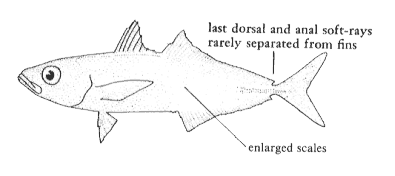
Family: Carangidae (Jacks)
Genus and Species:Trachurus symmetricus
Description: The body of the jack mackerel is rather elongate; somewhat compressed. The body tapers to a tail, which is as broad as it is deep. The color is metallic blue to olive green above becoming silvery below. The jack mackerel, which is not a true mackerel, is quite similar to the Mexican scad, but can be distinguished by the enlarged scales along the side and by the last rays of the dorsal and anal fins being attached to the body. These rays are isolated finlets on the Mexican scad.
Range: Jack mackerel occur from Magdalena Bay, Baja California, to southeast Alaska, and from the surface to depths of 150 feet. Adults may be found over 500 miles offshore.
Natural History: Jack mackerel are known to feed heavily upon crustaceans and small, free swimming mollusks. Half of the 1 year old females are sexually mature and will spawn, with 90 percent spawning at age 2. Spawning takes place from March through July, and occurs over an extensive area from 60 to 300 miles offshore. Jack mackerel regularly live 20-30 years and weigh 4 to 5 pounds. For fish with such a long life span, they become sexually mature at a very young age. They are quite common near the islands and banks off southern California up to 3 or 4 years of age, and then presumably move offshore or northward.
Fishing Information: Younger jack mackerel do not feed extensively on anchovies, do not readily bite on baited hook or lure, and thus are a much less common addition to the catch of a sport angler. They can be jigged, however, on small feathered hooks and frequently are used as a bait for larger gamefish by the experienced ocean angler.
Other Common Names: horse mackerel, Spanish mackerel, mackerel-jack, jackfish, Pacific jack mackerel.
Largest Recorded: 32 inches; a 28.5 inch jack mackerel weighed 5.25 pounds. Largest taken off California by a recreational angler: 5.5 pounds.
Habitat: Pelagic Environment
Yellowtail
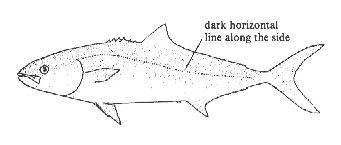
Family: Carangidae (Jacks)
Genus and Species:Seriola lalandi
Description: The body of the yellowtail is elongate, somewhat compressed, tapering to the sharp snout and the slender tail. The head is more or less conical. The color is olive brown to brown above, with a dark streak along the side of the body. The fins are yellowish. Yellowtail are easily distinguished from other fishes by the darker horizontal stripe along the side of the body, as well as a deeply forked yellow tail.
Range: Yellowtail occur from Chile to British Columbia, Canada, including the Gulf of California, and from the ocean’s surface to depths of 228 feet. Most fish landed in California are taken between Point Conception and the Coronado Islands, Baja California.
Natural History: Yellowtail feed primarily during the day and are opportunistic feeders, eating anything that is abundant in the area. Red crabs, anchovies, squid, and most small fishes are food items. Spawning occurs from June through October. Many yellowtail are sexually mature in 2 years; all will spawn when 3 years old. A 3 year old female will weigh about 10 pounds and spawn approximately 450,000 eggs; however, a 25 pound female will produce more than 1 million eggs.
Fishing Information: Prime yellowtail areas are found around the Coronado Islands, La Jolla Kelp, the area between Oceanside and Dana Point, Horseshoe Kelp, Palos Verdes Peninsula, Santa Catalina Island and San Clemente Island. Most yellowtail taken by California anglers are landed on boats which anchor at spots where yellowtail are known to aggregate and then chum the fish to the boat with live anchovies. As the fish mill about the boat, anglers then use anchovies, mackerel or squid to catch them. Small boaters may take yellowtail by trolling jigs or feathers in areas where these fish occur.
Other Common Names: California yellowtail, forktail, mossback, amberjack, white salmon.
Largest Recorded: 5 feet; 80 pounds (California).
Habitat: Pelagic Environment
Sargo
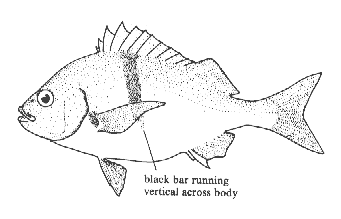
Family: Pristipomatidae (Sargos)
Genus and Species:Anisotremus davidsonii
Description: The body of the adult sargo is a compressed oval shape with the back elevated. The head has a steep, straightish upper profile and a small mouth. The color is metallic silvery, with a grayish tinge on the back and silvery below; with a distinguishing dark vertical bar running across the body. Occasionally, sargo are entirely bright yellow, orange or pure white. Young sargo, up to 4 inches, have several dark horizontal stripes. The vertical bar begins to appear when they are 2 or 3 inches long.
Range: The sargo occurs from Magdalena Bay, Baja California, to Santa Cruz, California, and is found inshore and in bays. Sargo occur from the surface to depths of 198 feet, but are most common in water up to 40 feet deep. They are usually found in areas with rock or combination rock-sand bottoms, around pilings or similar submerged structures.
Natural History: Examination of stomach contents indicate sargo are bottom feeders, eating different small shrimps, crabs, clams, and sea snails. Sargo spawn when they are about 7 inches long and 2 years old. Spawning occurs in late spring and early summer. The 1 inch young appear in late summer and fall in shallow water, schooling loosely with young salema and black croaker. At a length of 5 inches, when they are about 1 year old, they join adult sargo schools. All through their life they are capable of displaying the striped pattern characteristic of juveniles.
Fishing Information: Sargo are commonly caught incidentally to other fishing, primarily during the summer months. Anglers fishing from the rocks catch a few as part of their mixed fare and good runs are occasionally encountered in southern California bays. Sargo make a piglike grunting sound when pulled from the water. Almost any type of animal bait, such as clams, mussel, shrimp or pieces of fish, does well. Because of their habit of swimming a few feet off the bottom in loose schools and in shallow water, they are a prime target when spear fishing. Probably more are taken in this manner than by hook and line.
Other Common Names: China croaker, blue bass, black croaker, grunt.
Largest Recorded: 19.7 inches.
Habitat: Shallow Rocky Environment
California Marine Sportfish Identification: Rays
Last Updated October 17, 2013
Note: Please consult current fishing regulations for species presented in this booklet. To view information on safe fishing eating guidelines, please visit the OEHHA website.
Bat Ray
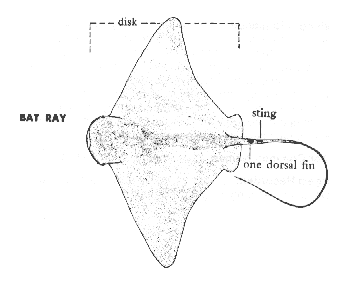
Family: Myliobatidae (Eagle rays)
Genus and Species:Myliobatis californica
Description: The bat ray has a distinct head that is elevated above the disk. The tail is whip-like and as long or longer than the width of the disk with the sting located just behind the body. The color is dark brown to dark olive or almost black above and white below. This species can be distinguished from manta rays or mobulas (that rarely occur off California) by the absence of the arm-like projections manta rays and mobulas have on their heads. Young are 8-12 inches disc width (wing span) at birth, with a maximum disc width of 6 feet.
Range: Bat rays are found from the Gulf of California to Oregon, from surface waters to depths of 150 feet.
Natural History: Bat rays feed chiefly upon mollusks and crustaceans. In bays and sloughs they feed heavily upon clams, oysters, shrimp and crabs. On the open coast they eat abalones and various other snails. When feeding, they swim along the bottom until they encounter currents of water expelled from the siphons of clams. They dig clams by suction created by flapping their wings. The shell of the ingested clam is crushed by their millstone like jaw teeth. Mating takes place during the summer months and the young are born alive, apparently the following summer, when they are 12 to 14 inches in width and weigh about 2 pounds. The young are always born tail-first with their wings rolled up over the body. They come equipped with a stinger and can cause severe painful wounds. Females apparently weigh at least 50 pounds and males 10 pounds before they are mature. Females of 50 to 60 pounds usually have two to four young; whereas, females of 130 to 140 pounds may have 10 or 12 young.
Fishing Information: Most sportfishing for bat rays takes place in protected bays and estuaries. Although bat rays may be taken in the open ocean, anglers prefer to catch them in sheltered waters. Heavy tackle is recommended since anglers often encounter large rays. Favorite baits include shrimp, clams, crabs or even cut mackerel.
Other Common Names: sting ray, eagle ray, batfish, stingaree, bat sting ray.
Largest Recorded: Maximum disc width 4 feet, 9 inches. Largest taken off California by a recreational angler: 181 pounds, no width.
Habitat: Shallow Sandy Environment
Round Stingray
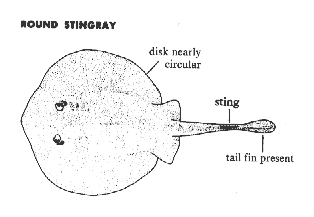
Family: Dasyatididae (Stingrays)
Genus and Species:Urolophus halleri
Description: The disk of the round stingray is nearly circular. The back of this species is brown, often mottled or spotted, and the underside is white to orange. The round stingray is one of six rays found in California waters which have a stinger on the tail. It can be distinguished from the others since it is the only one with a true tail fin. The others have either a whip-like tail or very short tail with no fin membrane.
Range: This species occurs from Panama to Humboldt Bay, California, including the Gulf of California. Round stingrays are most abundant off southern California and northern Baja California at depths up to 70 feet.
Natural History: Round stingrays obtain much of their food by burrowing in the substrate. Their diet includes worms, crabs, snails, clams and small fishes. It takes 3 months for the round stingray young to develop and they are approximately 3 inches wide at birth. Sexual maturity occurs at 6 years,, and mating occurs from May to June and in December. There are one to six pups, depending upon the size of the female.
Fishing Information: Most round stingrays are taken incidentally by anglers fishing for other species. However, should one wish to go after them specifically, marine worms or pieces of clam are good bait. Sandy or muddy bottoms along a beach or in a bay should provide good fishing. Round stingrays are potentially dangerous because of the wounds they can inflict. If an angler is stung, the wound should be cleaned thoroughly and bathed in water. One should see a doctor if pain persists or infection occurs.
Other Common Names: ray, stingray, stinger, stingaree.
Largest Recorded: 22 inches disc width; no weight recorded; however, a male 20 inches disc width weighed 1.5 pounds.
Habitat: Shallow Sandy Environment
California Marine Sportfish Identification: Sharks
Last Updated October 17, 2013
Note: Please consult current fishing regulations for species presented in this booklet. To view information on safe fishing eating guidelines, please visit the OEHHA website.
Blue | Bonito | Brown Smoothhound | Common Thresher | Gray Smoothhound | Leopard | Shortfin Mako | Shovelnose Guitarfish | Spiny Dogfish
Spiny Dogfish
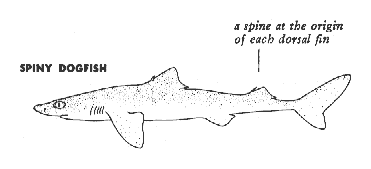
Family: Squalidae (Dogfish sharks)
Genus and Species: Squalus acanthias
Description: The body of the spiny dogfish is elongate and slender. The head is pointed. The color is slate gray to brownish on top, sometimes with white spots, becoming white below. This species and the horn shark are the only sharks along the California coast with spines at the beginning of both dorsal fins. These spines may be mildly poisonous and provide a defense for the spiny dogfish.
Range: Spiny dogfish occur in temperate to subarctic waters in the Atlantic and Pacific Oceans. In the eastern Pacific Ocean they are found off Chile, and from central Baja California to Alaska and to Japan. This species is common in nearshore waters along most of the coast. It is generally found in waters up to 1,200 feet deep though spiny dogfish have been taken to depths of 2,400 feet.
Natural History: The spiny dogfish feeds upon practically all smaller fishes such as herring, sardines, anchovies, smelts and even small spiny dogfish as well as crabs. The females are larger than the males, and produce from 3 to 14 young at a time and in alternate years. Most adults are 2 to 4 feet long. Spiny dogfish are long lived and non-migratory; as a result, heavy fishing pressure in a given area will lower the population level of this slow growing, low reproductive species quite rapidly.
Fishing Information: You are most likely to catch a spiny dogfish with anchovies or invertebrates on a rock cod jig.
Other Common Names: dog shark, grayfish, Pacific grayfish, spinarola, California dogfish.
Largest Recorded: 5.25 feet; no weight recorded; however, a large fat female about 4 feet long will weigh 15 pounds.
Habitat: Shallow Sandy Environment
Common Thresher Shark
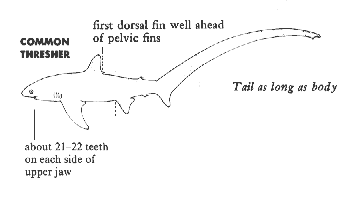
Family: Alopiidae (Thresher sharks)
Genus and Species: Alopias vulpinus
Description: The body of the common thresher shark is moderately elongate. The snout is rather short, and the mouth crescent shaped. The first dorsal fin is large, and located midway between the pectoral and ventral fins. The second dorsal and anal fins are very small. The tail is distinctive since it is very long, almost as long as the rest of the body. The coloration may vary from brownish gray, bluish or blackish above to silvery, bluish or golden below. The dorsal, pectoral and ventral fins are blackish and sometimes the pectoral and ventral fins have a white dot in the lip. The bigeye thresher also occurs off the California coast. It can be distinguished by its large eye; however, if you can count the teeth in the upper jaw, the common thresher has 21 – 22 on each side while the bigeye thresher has 10 – 11 on each side.
Range: The common thresher shark occurs worldwide in warmer seas. In the eastern North Pacific, it is found from central Baja California, to the Strait of Juan de Fuca, British Columbia. The common thresher is an inhabitant of the upper layers of deep offshore waters and is most abundant in areas of steep bottom contour along the edges of the continental shelf. During the spring and summer months smaller threshers may occur near shore where they are often seen leaping completely out of the water.
Natural History: The food habits of the thresher are not well known, but on the California coast they feed mostly upon small fish such as sardines, anchovies, mackerel, and squid. They are said to use their long tail as a flail to frighten or stun their prey. The common thresher shark bears live young and appears to become sexually mature in 6 or 7 years. Four pups are produced annually. A 18 foot female contained four young that weighed 13.5 pounds each and were 4 to 4.5 feet long.
Fishing Information: Most thresher sharks caught off California have been taken on live sardines, anchovies, or mackerel. Best localities have been the San Francisco Bay area, the inshore coastal water between Point Conception and Port Hueneme, and Santa Monica Bay, especially around Malibu and Paradise Cove. They are most abundant during the summer months. Considered a fine game species on light or medium tackle, they often put on an aerial demonstration. At other times the battle is entirely beneath the surface and consists of brute strength and shift-towing tactics. An angler would do well to bait a live mackerel on a 9/0 hook attached to 10 or so feet of heavy wire leader.
Other Common Names: thresher, blue thresher, green thresher, longtail shark, swiveltail, fox shark, sea fox.
Largest Recorded: 20 feet; 1,000 pounds. Largest taken off California by a recreational angler: 575 pounds.
Habitat: Pelagic Environment
Shortfin Mako Shark (formerly Bonito Shark)
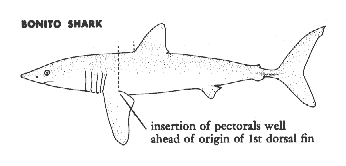
Family: Lamnidae (Mackerel shark)
Genus and Species: Isurus oxyrinchus
Description: The body of the shortfin mako shark is elongate but rather stout. The snout is long and pointed. The first dorsal and the pectoral fins are large, but the second dorsal and anal fins are very small. This species is a deep blue or dark gray above and white below. There is a black spot at the base of the pectorals.
Range: This shark is found worldwide in warm and temperate seas; in the eastern Pacific from Chile to the Columbia River, Washington, including the Gulf of California, but not in the tropics.
Natural History: The diet of the shortfin mako shark includes fishes and squid, often large ones. Whenever possible, the bonito shark takes its food in one gulp. With its tremendous speed, it is unquestionably a dangerous shark. Shortfin mako sharks bear live young.
Fishing Information: The shortfin mako (bonito) shark is one of the larger sharks to inhabit California waters. By all accounts, it is as dangerous as any shark, and it probably swims faster than most. The best way to hook a shortfin mako shark is by trolling with a whole tuna, squid or mackerel using a steel leader. You can also use lures, and chumming does help. Watch out, when you catch one, because this is a dangerous fish that will not hesitate to attack you or your boat.
Other Common Names: bonito, mako, mackerel shark, spriglio, paloma.
Largest Recorded: 13 feet; 1,250 pounds. Largest taken off California by a recreational angler: 1098 pounds.
Habitat: Pelagic Environment
Gray Smoothhound
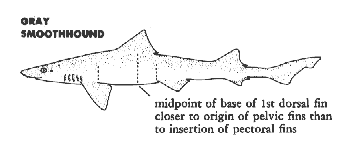
Family: Carcharhinidae (Requiem sharks)
Genus and Species: Mustelus californicus
Description: The body of the gray smoothhound is elongate, slender, tapering from behind the dorsal fin to a long slender tail. The snout is comparatively long and flattened. The color is brown to dark gray above and whitish below. The gray smoothhound can be distinguished from other smoothhounds by scales present on the posterior one-fifth of the dorsal fin and the teeth are blunt.
Range: This species occurs from Mazatlan, Mexico, to Cape Mendocino, California; and is found in shallow waters to depths of 150 feet.
Natural History: The diet of the gray smoothhound includes crabs, shrimp and small fishes. The female bears the young alive.
Fishing Information: Although the gray smoothhound is of relatively minor importance to sport anglers, it is commonly taken in the surf. It is edible, but not as tasty as the brown smoothhound. If you’re fishing in southern California, you are most likely to catch a gray, and in central California, you are most likely to catch a brown smoothhound.
Other Common Names: shark, dogfish, paloma, sand shark, gray shark.
Largest Recorded: 5 feet 4.25 inches; no weight recorded.
Habitat: Shallow Sandy Environment
Brown Smoothhound
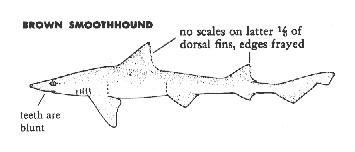
Family: Carcharhinidae (Requiem sharks)
Genus and Species: Mustelus henlei
Description: The body of the brown smoothhound is elongate, slender, tapering from behind the dorsal fin to the long slender tail. The snout is comparatively long and flattened. The color is brown or bronze above and silvery below. The back one-fifth of the dorsal fin is without scales. The teeth are sharp. The brown and other smoothhounds can be distinguished from the soupfin shark since their second dorsal fins originate well in advance of the beginning of the anal fin; while in the soupfin, the second dorsal begins behind the origin of the anal fin.
Range: The brown smoothhound occurs from the Gulf of California to Humboldt Bay, California. It is found at depths from shallow water to 360 feet.
Natural History: The diet of the brown smoothhound includes crabs, shrimp, and small fishes. Females bear their young live, as do most other sharks.
Fishing Information: The brown smoothhound is a relatively small shark, and is one of the most abundant sharks in the central California sport fishery. This is a good sport species on light tackle, and can be taken in bays from San Francisco to Point Conception. Good baits to use include crabs, shrimp and small fishes. The brown smoothhound is considered a very good table fish.
Other Common Names: mud shark, dogfish, paloma, sand shark, Henle’s shark.
Largest Recorded: 3 feet 1 inch; no weight recorded.
Habitat: Shallow Sandy Environment
Leopard Shark
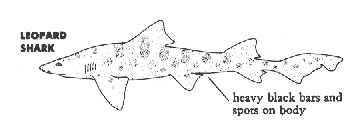
Family: Carcharinidae (Requiem sharks)
Genus and Species: Triakis semifasciata
Description: The body of the leopard shark is elongate, and the snout is short and bluntly rounded. This shark is easily identified by the gray coloration over most of its body, and the black spots and crossbars on the back and side. It is white underneath.
Range: Mazatlan, Mexico, to Oregon. This well decorated species is abundant in bays and along sandy beaches of southern and central California in shallow water. During the fall, large numbers may be found in San Francisco and Monterey Bays.
Natural History: The leopard shark eats a variety of fishes and invertebrates like anchovies, squid or crab, all of which make good bait. Females, which bear their young live, usually produce 4 to 29 pups in a litter.
Fishing Information: It is considered a relatively harmless shark and is timid around divers; nevertheless, handle a live leopard shark with care. The leopard shark is very good eating, and has been compared favorably to salmon.
Other Common Names: cat shark.
Largest Recorded: 7 feet; 70 pounds.
Habitat: Bay Environment
Blue Shark
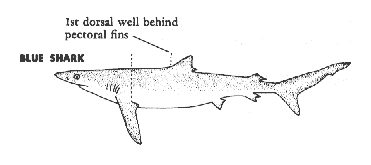
Family: Carcharhinidae (Requiem sharks)
Genus and Species: Prionace glauca
Description: The body of the blue shark is elongate and slender. Its head is slender and the snout is long and pointed. The color is blue or light bluish gray above and white below. This species has up to three rows of functional teeth in each jaw and there are 14 or 15 serrated teeth in each side of each jaw. The pectoral fins are long and sickle shaped.
Range: The blue shark occurs worldwide. In the eastern Pacific, blue sharks are found from Chile to the Gulf of Alaska, but not in the tropics. It is common off southern California most of the year, but during warm water periods occurs much further north.
Natural History: Blue sharks do not mature until they attain a length of 7 or 8 feet. Of several thousand blue sharks taken on longline gear, the smallest female was 7 feet long. A female weighing 95 pounds and 7 feet 7 inches long, contained 26 apparently fully developed young ranging in length from 15.5 to 17.75 inches. As many as 54 young have been counted in a single adult female captured in the Mediterranean Sea.
Fishing Information: Most are taken incidentally by albacore or rockfish anglers. Should you wish to specifically fish for blue sharks, they are easily taken once located. Either casting a bait at a previously located fish or chumming in an area known to be inhabited by blue sharks will usually produce results. Dead fish or squid make excellent bait, and ground up anchovies make good chum. Blue sharks tend to “roll up” on the line, so it is necessary to use a long wire leader to avoid cutting the line on the shark’s skin. The fish may be eaten, but it is necessary to bleed it while it is still alive. After it is dead it should be cleaned, skinned and soaked as soon as possible to avoid the taste of urea in the meat.
Other Common Names: blue whaler, great blue shark.
Largest Recorded: 8.3 feet. Largest taken off California by a recreational angler: 258.5 pounds in 2008.
Habitat: Pelagic Environment
Shovelnose Guitarfish
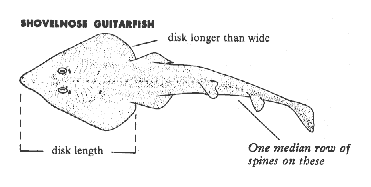
Family: Rhinobatidae (Guitarfishes)
Genus and Species: Rhinobatos productus
Description: The body of the shovelnose guitarfish is depressed and gradually tapers into the tail; the disk is longer than wide. The snout is rather long and rounded at the tip. The color is gray above becoming lighter below. This species is distinguished from the banded guitarfish by the absence of dark crossbars on the back. It can be separated from most others of this flattened and plated group by the presence of a tail fin and two dorsal fins. Its sharp pointed nose distinguishes it from the other guitarfishes.
Range: Gulf of California to San Francisco, California. The shovelnose can be found, sometimes in large numbers, over sand or mud sand bottoms in colder, shallow coastal waters.
Natural History: The guitarfish diet consists of a variety of crustaceans, worms and clams. They have been observed feeding on sand crabs in water less than 3 inches deep. At times they are left stranded on the beach by receding waves and must wiggle their way back into the water much like grunion. Shovelnose guitarfish bear live young, with as many as 28 from a single female. Mating takes place during the summer months and the young, apparently born during the following spring and summer, are 6 inch miniatures of the adults
Fishing Information: Shovelnose guitarfish are caught in the surf, in bays and from piers. They take live or dead bait including clams, mussels, sand crabs and almost any other bait or lure. The flesh, especially the tail and back straps, is considered quite good.
Other Common Names: shovelnose shark, pointed nosed guitarfish, guitarfish.
Largest Recorded: 5 feet 1.5 inches; 40.5 pounds.
Habitat: Shallow Sandy Environment
California Marine Sportfish Identification: Rockfish
Last Updated October 17, 2013
Note: Please consult current fishing regulations for species presented in this booklet. To view information on safe fishing eating guidelines, please visit the OEHHA website.
Black Rockfish | Blue Rockfish | Bocaccio | Canary Rockfish | Chilipepper | Copper Rockfish | Cowcod | Greenspotted Rockfish | Olive Rockfish | California Scorpionfish aka Sculpin | Starry Rockfish | Vermilion Rockfish | Widow Rockfish | Yellowtail Rockfish
California Scorpionfish aka Sculpin
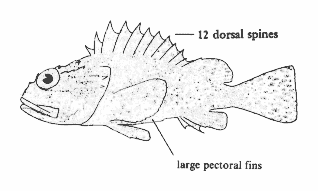
Family: Scorpaenidae (Scorpionfishes)
Genus and Species:
Scorpaena guttataDescription: The body of the California scorpionfish is stocky and slightly compressed. The head and mouth are large, as are the pectoral fins. The color is red to brown, with dark blotches and spotting over the body and fins.
Range: The California scorpionfish occurs between Uncle Sam Bank, Baja California, and Santa Cruz, California, with an isolated population in the Gulf of California. They are caught over hard, rocky bottoms at depths ranging from just below the surface to 600 feet. Some may occasionally be taken over sand or mud bottoms.
Natural History: The diet of the California scorpionfish includes crab, squid, octopus, fishes and shrimp. California scorpionfish first spawn when they are 3 or 4 years old. Spawning takes place from April through August, and probably occurs at night. The eggs are embedded in the gelatinous walls of hollow, pear shaped egg-balloons. The paired egg-balloons, each 5 to 10 inches long are joined at their small ends. The walls of these “balloons” are about 0.1 inch thick, transparent or greenish in color, and contain a single layer of eggs. Each egg is about 0.05 inch in diameter. The “balloons” are released at the bottom of the sea and rise rapidly to the surface. The eggs hatch within 5 days, 58 to 72 hours after the egg balloon is released. Maximum estimated age is 21 years.
Fishing Information: California scorpionfish readily take a hook that has been baited with a piece of squid or fish and lowered to the bottom in a rocky area where they are known to inhabit. A lot of rebaiting time can be saved by utilizing a “difficult to steal” bait. At times, a considerable amount of chumming with ground fish will attract California scorpionfish to the surface. Hooked California scorpionfish are not noted for their fighting qualities. The California scorpionfish is the most venomous member of the scorpionfish family in California. Its dorsal, pelvic and anal fin spines are associated with venom glands and are capable of causing an extremely painful wound. Penetration of the skin by any of these spines is followed almost immediately by intense and excruciating pain in the area of the wound. Many treatments have been used for California scorpionfish stings, but immersion of the affected part in very hot water seems to be the most effective. Multiple punctures can be quite serious, producing shock, respiratory distress or abnormal heart action and may require hospitalization of the victim.
Other Common Names: spotted scorpionfish, scorpion, rattlesnake, bullhead, scorpene.
Largest Recorded: 17 inches; no weight recorded; however, a 15.25 inch female weighed 3.5 pounds.
Habitat: Shallow Rocky Environment
Black Rockfish
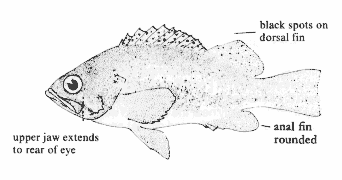
Family: Scorpaenidae (Scorpionfishes)
Genus and Species:
Sebastes melanopsDescription: The body of the black rockfish is oval or egg-shaped and compressed. The head has a steep upper profile which is almost straight; the mouth is large and the lower jaw projects slightly. The color is brown to black on the back, paler on the sides, and dirty white below. There are black spots on the dorsal fin. This species is easily confused with the blue rockfish; however, the anal fin of the black rockfish is rounded while the anal fin of the blue rockfish is slanted or straight. The black rockfish has spots on the dorsal fin, the blue rockfish does not.
Range: Black rockfish occur from Amchitka Island to Huntington Beach. They are wide-ranging fish that can live on the surface or on the bottom to 1,200 feet near rocky reefs or in open water over deep banks or drop-offs.
Natural History: The diet of the black rockfish includes squid, crab eggs, and fishes. Black rockfish are ovoviviparous, like all members of this family fertilization and development of the embryo take place in the body of the mother. When embryonic development is complete, the female releases the eggs and the exposure to sea water activates the embryo and it escapes from the egg case.
Fishing Information: These fish are commonly caught from commercial passenger fishing vessels and when trolling for salmon. Use similar fishing techniques as for blue rockfish. Conservation methods (seasons, hooks, depth) for rockfish vary by area, so be sure to check the current regulations before going out.
Other Common Names: black snapper, black bass, gray rockfish, red snapper.
Largest Recorded: 27.6 inches; 11 pounds.
Habitat: Shallow Rocky Environment
Blue Rockfish
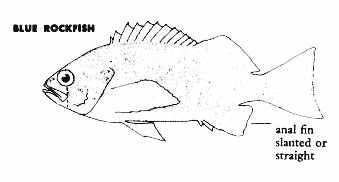
Family: Scorpaenidae (Scorpionfishes)
Genus and Species:
Sebastes mystinusDescription: The body of the blue rockfish is oval or egg-shaped and compressed with similar dorsal and ventral profiles. The head is relatively short and bluntly pointed. The mouth is relatively small with the lower jaw slightly projecting. The color is dark blue or olive brown to grayish black on the back becoming lighter below; blotched with lighter shades on back and sides. The presence of five spines on the preopercle (gill cover), easily distinguish this species as a rockfish rather than a perch, a bass or a halfmoon which is of similar color. The black rockfish can be confused with this species; however, the black rockfish has spots on the dorsal fin while the blue rockfish does not. The anal fin of the black rockfish is rounded while that of the blue rockfish is slanted or straight.
Range: The blue rockfish occurs from Punta Baja, Baja California, to the Bering Sea. It is a schooling species that is often caught in large numbers over rocky bottoms and around kelp beds. It is most commonly caught from the surface to 100 feet, although it has been taken from depths as great as 300 feet.
Natural History: Blue rockfish principally eat salps, jellyfish, crustaceans, small fishes and algae. Algae may be accidentally ingested while picking up small shrimp and other tidbits. As with other rockfishes, fertilization is internal and live young are born which are quite small and helpless. A 16 inch female contained just over 500,000 eggs. The main spawning season runs from about November to March. Maximum age: 24 years..
Fishing Information: Blue rockfish can be caught in quantity near rocky shores and around breakwaters, sunken ships, piles of rubble and similar localities along the entire California coastline, especially north of Point Conception. They are caught just beneath the surface in and around kelp beds, but where there is no kelp they live mostly near the bottom. Almost any kind of cut fish will prove productive bait. Mussel, clam, crab, shrimp and squid strips work almost equally as well, as do some kinds of wet flies and other artificial lures. Blue rockfish are noted for putting up an excellent battle when hooked. Conservation methods (seasons, hooks, depth) for rockfish vary by area, so be sure to check the current regulations before going out.
Other Common Names: blue bass, blue fish, reef perch.
Largest Recorded: 21 inches; no weight recorded; however, a 15 inch female weighed 1.75 pounds. Largest taken off California by a recreational angler: 3 pounds, 14 ounces.
Habitat: Shallow Rocky Environment
Bocaccio
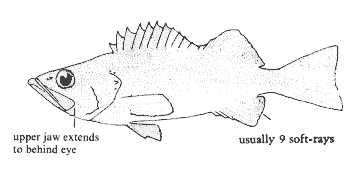
Family: Scorpaenidae (Scorpionfishes)
Genus and Species:
Sebastes paucispinusDescription: The body of the bocaccio is elongate and compressed. The head is pointed, the mouth large, and the lower jaw greatly protruding. The color varies from shades of brown to reddish and extends down over the belly. Young fish are generally light bronze with speckling over the sides and back. As they mature, their color generally becomes darker and the speckling gradually disappears.
Range: Bocaccio occur from Punta Blanca, Baja California, to Kruzof Island and Kodiak Island, Alaska. Young bocaccio 1 or 2 years old travel in loose schools and move into shallow water where they may be captured in quantity. With increasing age they seek deeper water and move from near the surface to near the bottom. Adults are commonly found in waters of 250 to 750 feet over a somewhat irregular, hard or rubble bottom. They have been found at depths as great as 1,050 feet.
Natural History: The diet of bocaccio includes mainly fishes such as surfperch, jack mackerel, sablefish, anchovies, sardines, Pacific mackerel, deepsea lanternfish, other rockfishes and sanddabs. Squid, octopus, and crab also are eaten. Females start maturing when they are 17 inches long. As with all rockfish, fertilization is internal and development of the embryos takes place within the ovaries of the female until they are ready to hatch. A 28 inch female was estimated to contain nearly 1.5 million eggs. The main hatching period runs from December through April. The newly hatched young, about 0.25 inch long, does not completely absorb the yolk from the egg stage for a period of 8 to 12 days.
Fishing Information: Bocaccio can be found just off the bottom over almost any rocky or rubble bottom at various depths. A typical rockfish rig consists of one or two hooks with enough weight to get to the bottom on a fairly straight course. Bait is usually strips of squid, live anchovies or sardines or lead head scampi, sometimes jigs are used. Conservation methods (seasons, hooks, depth) for rockfish vary by area, so be sure to check the current regulations before going out.
Other Common Names: salmon grouper, grouper, mini-grouper (juveniles), red snapper, Pacific red snapper.
Largest Recorded: 3 feet; 21 pounds.
Habitat: Deep Rocky Environment
Chilipepper
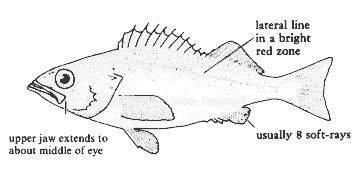
Family: Scorpaenidae (Scorpionfishes)
Genus and Species:
Sebastes goodeiDescription: The body of the chilipepper is slender and rather elongate. The head is elongate, pointed and with no spines; the lower jaw is projecting. The chilipepper is generally pinkish becoming whitish below. The middle of the chillipepper’s side, the lateral line, stands out clearly, as a lighter, bright red zone. In comparison to the bocaccio, it has a smaller mouth with an upper jaw that extends only to about the center of the eye, not past it. Maximum length: 23 inches.
Range: This species occurs from Magdalena Bay, Baja California, to Vancouver Island, British Columbia. Chilipeppers are not taken as frequently as other rockfishes because they are rarely caught in depths less than 360 feet along the coast of California. They generally occur over rocky bottoms and have been taken as deep as 1,080 feet.
Natural History: Adult chilipepper feed on small crustaceans, small squids, or on such fishes as anchovies, young hake, small sardines, and lanternfishes. Approximately 50 percent of the males mature when 8.75 inches long and 2 years old; while 50 percent of the females are mature when they are 12 inches long and 4 years old. Chilipeppers may live to be 35 years old. As with other rockfishes, fertilization is internal and live young are born. The number of developing eggs increases from 29,000 in a 12 inch female to about 538,000 in a 22 inch fish.
Fishing Information: Chilipepper are often fished in midwater as well on the bottom. When fishing for chilipepper in deeper waters, the typical rockfish rig and bait is appropriate (see bocaccio). Conservation methods (seasons, hooks, depth) for rockfish vary by area, so be sure to check the current regulations before going out.
Other Common Names: chili, red snapper.
Largest Recorded: 22 inches; 5.25 pounds.
Habitat: Deep Rocky Environment
Cowcod – NO FISHING ALLOWED
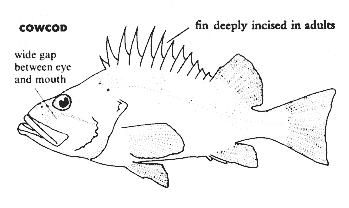
Family: Scorpaenidae (Scorpionfishes)
Genus and Species:
Sebastes levisDescription: The body and head of the cowcod are somewhat compressed. The head is very large. The mouth is large with a projecting lower jaw. Adults are uniform pale pink to orange in color. Young fish have four dark vertical bands on their sides which gradually fade into dusky blotches as they increase in size. Their heads are large and spined, the dorsal fins are deeply notched, and there is an unusually wide space between the eye and the upper jaw. These three characteristics help to distinguish cowcod from other reddish colored rockfish.
Range: Cowcod occur from Ranger Bank and Guadalupe Island, Baja California, to Newport, Oregon. This is a deeper water species occurring at depths from 130 feet (young) to 1,200 feet. Cowcod are found over rocky bottoms, particularly where there are sharp, steep drop-offs.
Natural History: The diet of the cowcod includes mainly fishes, octopus, and squid. Juvenile cowcod eat small shrimp and crabs. Like all members of the genus Sebastes, the cowcod gives birth to live young. These are less than 0.5 inches in length and are produced in great numbers. The young are free floating and may be found in shallower water; however, as they grow larger they move to deeper water.
Fishing Information: No fishing allowed. The species is not expected to recover until 2060.
Other Common Names: cow, cow rockfish, cowfish, red snapper.
Largest Recorded: 37 inches; 28.5 pounds.
Habitat: Deep Rocky Environment
Olive Rockfish
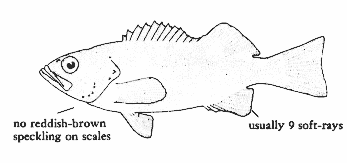
Family: Scorpaenidae (Scorpionfishes)
Genus and Species:
Sebastes serranoidesDescription: The body of the olive rockfish is elongate and compressed. The upper profile of the head is almost straight, and the snout is long and pointed. The lower jaw is projecting. The olive rockfish is dark olive brown on the back, often with some light areas under the dorsal fin. The sides are a lighter olive green, and the fins are yellow. This species is very similar in appearance to the yellowtail rockfish. The olive rockfish always has nine soft rays in the anal fin; the yellowtail rockfish usually has eight.
Range: This species occurs from the San Benito Islands, Baja California, to Redding Rock, California. Olive rockfish are generally caught in nearshore waters. They are found primarily around reefs and kelp beds in water less than 150 feet deep, but have been caught as deep as 480 feet.
Natural History: The diet of olive rockfish consists primarily of fishes; however, crab, shrimp, and squid also are consumed in smaller quantities. Olive rockfish mature and spawn for the first time when they are 3 or 4 years old. As is true among the other rockfish, fertilization is internal and live young are born. The main spawning season is from December through March and a large female may spawn as many as 500,000 young during the season.
Fishing Information: Olive rockfish may be found in almost every kelp bed along the mainland shore south of Monterey Bay, California. The best bait is a lively anchovy. The bait should be cast directly into the floating fronds of kelp and no sinker should be used. If there are any olive rockfish around they will hit the bait right at the surface, usually so hard that they set the hook themselves. The ensuing battle is excellent in every respect and the larger the fish the better the fight. Olive rockfish will also strike a streamer fly or a properly worked metal lure or small wooden plug. Conservation methods (seasons, hooks, depth) for rockfish vary by area, so be sure to check the current regulations before going out.
Other Common Names: johnny bass, johnathans.
Largest Recorded: 24 inches; no weight recorded. Largest taken off California by a recreational angler: 5 pounds, 14 ounces.
Habitat: Shallow Rocky Environment
Yellowtail Rockfish
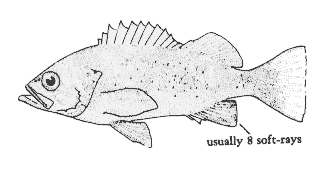
Family: Scorpaenidae (Scorpionfishes)
Genus and Species:
Sebastes flavidusDescription: The body of the yellowtail rockfish is elongate and compressed. The head is rather long and the upper profile is steep and slightly curved. The lower jaw projects, but not beyond the upper profile of the head. The color is grayish brown above which shades to white below. The sides are finely spotted with yellow. The tail is yellow, while the other fins are dusky yellow. When the fish is fresh, reddish brown speckling is visible on some of the scales. As with many of the rockfish, identification can be somewhat difficult. Some of the distinguishing characteristics of the yellow tail rockfish include a convex (surface curves outward) space between the eyes, the absence of spines on top of the head, a projecting lower jaw, an anal fin with eight (rarely seven) soft rays and the lining of the belly is white. Maximum length: 28 inches.
Range: The yellowtail rockfish occurs from San Diego, California, to Unalaska Island, Alaska; however, it is most often caught by recreational anglers off of central and northern California. It is regularly found over deep reefs from the surface to depths of 1,800 feet.
Natural History: Adult yellowtail rockfish feed on small hake, anchovies, lanternfishes, and other small fishes, as well as on small squid, and other shrimp-like organisms. These are all good baits to use for the yellowtail rockfish. A few yellowtail rockfish mature when 11 inches long or 3 years old. Fifty percent are mature when 15-18 inches long or 6 years old. They may live to be 64 years old. As with other rockfishes, fertilization is internal and live young are born. The number of developing eggs increases from 56,000 in a fish 12 inches long to about 1,993,000 in a fish 19 to 21 inches long.
Fishing Information: Yellowtail rockfish occur quite often at or near the surface, thus, standard surface fishing techniques and baits such as anchovies or squid fished on a small hook are effective. Small silvery lures or small lead and rubber jigs also work well. When fishing for yellowtail rockfish in deeper waters, the typical rockfish rig and bait is appropriate although with less weight than for bocaccio. Conservation methods (seasons, hooks, depth) for rockfish vary by area, so be sure to check the current regulations before going out.
Other Common Names: red snapper, yellowtail.
Largest Recorded: 26 inches; no weight recorded; however, a yellowtail rockfish 24 inches long will weigh about 7.5 pounds.
Habitat: Shallow Rocky Environment
Canary Rockfish – NO FISHING ALLOWED
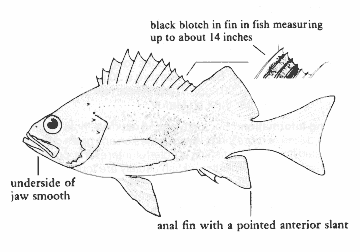
Family: Scorpaenidae (Scorpionfish)
Genus and Species:
Sebastes pinnigerDescription: The body of the canary rockfish is elongate, moderately deep and compressed. The head is large with an upper profile that is somewhat curved. The color is yellow orange with gray mottling on the back and paler, near white, below. The fins are also yellow orange. The middle of the sides are in a clear, gray zone. There is often a black spot near the back of the first dorsal fin in fish shorter than 14 inches. Although the canary rockfish resembles the vermilion rock fish superficially, the two are easily separated. The underside of the lower jaw of the canary rockfish has no scales and feels smooth to the touch when rubbed from back to front. The vermilion rockfish has scales on the underside of its lower jaw so that it feels rough when rubbed forward.
Range: Canary rockfish occur from Cape Colnett, Baja California, to Cape San Bartolome, Alaska. Canary rockfish are usually caught at depths of 50 to 300 feet, although juveniles have been taken at the surface and adults have been taken from depths as great as 900 feet. They are found around reefs and over soft bottoms.
Natural History: Adult canary rockfish feed on small crustaceans as well as anchovies, sanddabs, and other small fishes. The canary rockfish, like all members of the genus Sebastes, produces live young. Fertilization and embryo development take place within the body of the mother. The number of eggs increases from 69,000 in a10 inch female to about 1,113,000 in a female 21 inches long. About 50 percent of canary rockfish are mature at a length of 17 inches, or when they are 5 to 6 years old. They may live to be 75 years old.
Fishing Information: No fishing allowed. The species is not expected to recover until 2027.
Other Common Names: red snapper, fantail, canary, orange rockfish.
Largest Recorded: 30 inches; no weight recorded; however, a 24 inch canary rockfish weighs about 7 pounds.
Habitat: Deep Rocky Environment
Vermilion Rockfish
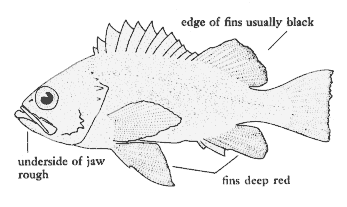
Family: Scorpaenidae (Scorpionfishes)
Genus and Species:
Sebastes miniatusDescription: The body of the vermilion rockfish is moderately deep and compressed. The upper profile of the head is some what curved; the mouth is large, with the lower jaw slightly projecting. The color is bright red on the body and fins; many with black and gray mottling on back and sides. On fish shorter than 12 inches, the mottling is much more apparent and the fins are often edged with black. The yelloweye and canary rockfishes are similar in appearance to the vermilion, but the bottom of the yelloweye and canary’s lower jaws are scaleless and feels smooth to the touch. The vermilion rockfish has scales on the bottom of the lower jaw which make it rough to the touch.
Range: Vermilion rockfish occur from Prince William Sound, Alaska to San Benito Island, Baja California. They are generally caught over rocky bottoms at depths of 100 to 500 feet, although they have been taken from depths as great as 900 feet. Maximum depth: 1400 feet.
Natural History: The free swimming young of the vermilion rockfish feed primarily upon shrimp-like organisms, while the larger, bottom-living adults feed almost exclusively upon fishes, squid and octopus. Most fishes that are eaten are other smaller kinds of rockfish. Vermilion rockfish appear to mature and spawn for the first time when they are 14 inches long (5-6 years old). As with all other rockfish, fertilization is internal and they give birth to living young. A vermilion rockfish that is 12.5 inches long is estimated to contain 63,000 eggs, and one that is 21.5 inches long is expected to contain 1,600,000 eggs. The principal reproductive period lasts from December through March.
Fishing Information: Vermilion rockfish can be found just off the bottom over almost any rocky or rubble bottom at various depths The same rig, bait, and technique used for bocaccio works for vermilion rockfish. Conservation methods (seasons, hooks, depth) for rockfish vary by area, so be sure to check the current regulations before going out.
Other Common Names: red snapper, red rock cod.
Largest Recorded: 30 inches; no weight recorded; however, they attain a weight of at least 15 pounds. Largest taken off California by a recreational angler: 14 pounds, 9 ounces.
Habitat: Deep Rocky Environment
Copper Rockfish
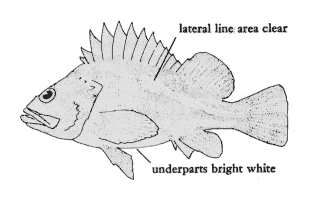
Family: Scorpaenidae (Scorpionfishes)
Genus and Species:
Sebastes caurinusDescription: The body of the copper rockfish is moderately deep and compressed. The head is large with a slightly curved upper profile; the mouth is large and the lower jaw projects slightly. The color is copper brown to orange tinged with pink. The back two-thirds of the sides are a clear, light pink area; the belly is white. The lateral line is in a white line along the body.
Range: The copper rockfish occurs from San Benitos Islands, Baja California, to the Kenai Peninsula, Alaska. It is found in shallow rocky and sandy areas, and is generally caught at depths of less than 180 feet; however, some have been found as deep as 600 feet.
Natural History: The diet of copper rockfish includes snails, worms, squid, octopus, crabs, shrimps, and fishes. Copper rockfish, like all species in the genus Sebastes, give birth to fully developed embryos. Fertilization and development of the embryo take place in the body of the mother. Upon being expelled from the female, the fully developed embryo is released from the egg.
Fishing Information: Copper rockfish can be found near the bottom over rocky habitat. The same rig, bait, and technique used for bocaccio works for copper rockfish. Conservation methods (seasons, hooks, depth) for rockfish vary by area, so be sure to check the current regulations before going out. The copper rockfish is often the last species to die in a bag of rockfish. Some individuals continue to twitch long after members of other species have died.
Other Common Names: never die, whitebelly, chucklehead, white belly.
Largest Recorded: 22.5 inches; no weight recorded.
Habitat: Shallow Rocky Environment
Widow Rockfish
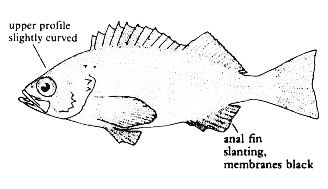
Family: Scorpaenidae (Scorpionfishes)
Genus and Species:
Sebastes entomelasDescription: The body of the widow rockfish is elongate and compressed. The head is relatively short, and the upper profile is slightly curved. The mouth is relatively small, the lower jaw projects slightly. The color is brassy brown over most of the body with the belly generally lighter in color, often with a reddish cast. The fin membranes, particularly in the anal and pectoral fins, are black. Specimens smaller than 10 inches are lighter in color and are tinged with vague streaks of orange.
Range: Widow rockfish occur from Todos Santos Bay, Baja California, to Kodiak Island, Alaska.
Natural History: Adult widow rockfish feed extensively on small free floating crab-like animals. Occasionally salps, small squids and anchovies are eaten. A few mature when 12 inches long and 3 years old. Fifty percent are mature when 13.5 inches long or 5 years old. As with other rockfish fertilization is internal and the young are born live. The number of developing eggs increases from 55,600 in fish 13 inches long, to about 915,200 in a fish 19 inches long. Widow rockfish may live to 60 years old.
Fishing Information: Widow rockfish are generally caught by sport anglers fishing on or just above the bottom in deep water, although young fish may be taken at or near the surface. On occasion, widow rockfish form huge schools in midwater. Conservation methods (seasons, hooks, depth) for rockfish vary by area, so be sure to check the current regulations before going out.
Other Common Names: widow, widowfish, red snapper.
Largest Recorded: A 20 inch widow rockfish will weigh about 4 pounds. Maximum size: 24 inches or 6.6 pounds.
Habitat: Deep Rocky Environment
Greenspotted Rockfish
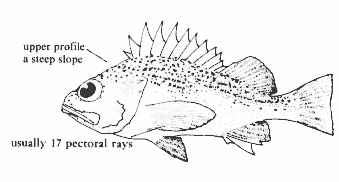
Family: Scorpaenidae (Scorpionfishes)
Genus and Species:
Sebastes chlorostictusDescription: The body of the greenspotted rockfish is elongate and moderately compressed. The upper profile of the head is rather steep with a nearly straight slope. The jaws are even when closed. The color is yellow pink with distinct green spots over the back and top of the head. There are three to five white blotches with green borders along the upper back, and the pectoral fins carry 17 rays. The underside of the lower jaw has no scales and is smooth to the touch. Two other species, the greenblotched rockfish and pink rock fish, are nearly identical to the greenspotted rockfish. Nevertheless, they can be distinguished from the greenspotted rockfish by the small patches of scales on the underside of their lower jaws. These two look-alike species attain a larger size than the greenspotted rockfish, but are not encountered as frequently since they usually inhabit deeper water.
Range: The greenspotted rockfish occurs from Cedros Island, Baja California, to Copalis Head, Washington. Greenspotted rockfish are caught around offshore, rocky reefs at depths ranging from 160 to 660 feet.
Natural History: As with other rockfishes, fertilization is internal and live young are born. The young are born during the period of April through July.
Fishing Information: The greenspotted rockfish is a common species in the deep-water rockfish catch. It is not considered very desirable, however, because of its small size. The typical rockfish rig and baits are appropriate gear (see bocaccio). Conservation methods (seasons, hooks, depth) for rockfish vary by area, so be sure to check the current regulations before going out.
Other Common Names: chucklehead, red rock cod, bolina.
Largest Recorded: 19.75 inches; no weight recorded.
Habitat: Deep Rocky Environment
Starry Rockfish
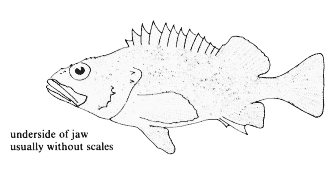
Family: Scorpaenidae (Scorpionfishes)
Genus and Species:
Sebastes constellatusDescription: The body of the starry rockfish is elongate, robust, heavy forward tapering to the tail. The head is rather pointed in profile and the mouth is large with the lower jaw projecting only slightly beyond the upper jaw when the mouth is closed. The body is red orange and profusely covered with small white spots. There are four or five large whitish blotches along the back. It is a very distinctive fish that is not easily confused with any other rockfish.
Range: The starry rockfish occurs from Thetis Bank, Baja California, to San Francisco, California, and is found around rocky offshore reefs at depths of 80 to 900 feet.
Natural History: As with other kinds of rockfish, fertilization is internal and live young are born. The young are usually born during March through May.
Fishing Information: Starry rockfish contribute to the recreational anglers offshore reef catch. The typical rockfish rig and baits are appropriate gear (see bocaccio). Conservation methods (seasons, hooks, depth) for rockfish vary by area, so be sure to check the current regulations before going out.
Other Common Names: spotted corsair, spotted rockfish, chinafish, red rock cod.
Largest Recorded: 18 inches; no weight recorded.
Habitat: Deep Rocky Environment
California Marine Sportfish Identification: Croakers
Last Updated October 17, 2013
Note: Please consult current fishing regulations for species presented in this booklet. To view information on safe fishing eating guidelines, please visit the OEHHA website.
California Corbina | Queenfish | Spotfin Croaker | White Croaker | White Seabass | Yellowfin Croaker
Queenfish
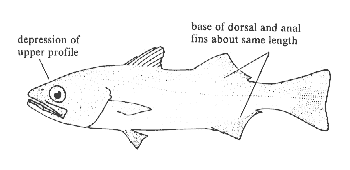
Family: Sciaenidae (Croakers)
Genus and Species: Seriphus politus
Description: The body of the queenfish is elongate and moderately compressed. The head is compressed with the upper profile depressed over the eyes. The mouth is large. The color is bluish above becoming silvery below and the fins are yellowish. Queenfish can be distinguished from other croakers by their large mouth, the base of the second dorsal and anal fins being about equal, and the wide space between the two dorsal fins. Maximum length: 20.5 inches.
Range: Queenfish occur from Uncle Sam Bank, Baja California, to Yaquina Bay, Oregon. They are common during summer in shallow water around pier pilings on sandy bottoms. They are found at depths up to 180 feet; however, occur more often from 4 to 27 feet. Queenfish are common in southern California, but are rare north of Monterey, California.
Natural History: Queenfish feed on small, free swimming crustaceans, small crabs, and fishes. Adult queenfish spawn in the summer. The eggs are free floating. Tiny young queenfish, less than 1 inch long, appear in late summer and fall; first at depths of 20 to 30 feet, gradually moving shoreward until they enter the surf zone when 1 to 3 inches long.
Fishing Information: Queenfish may be caught using live anchovies as bait. They are quite often the most commonly caught fish by anglers from piers.
Other Common Names: herring, kingfish, herring croaker, shiner.
Largest Recorded: 20.5 inches; no weight recorded.
Habitat: Shallow Sandy Environment
White Seabass
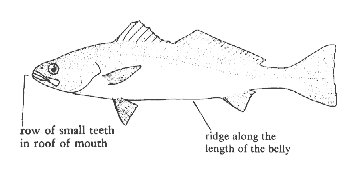
Family: Sciaenidae (Croakers)
Genus and Species: Atractoscion, nobilis*
*previously known as Cynoscion nobilis.
Description: The body of the white seabass is elongate, and somewhat compressed. The head is pointed and slightly compressed. The mouth is large, with a row of small teeth in the roof; the lower jaw slightly projects. The color is bluish to gray above, with dark speckling, becoming silver below. The young have several dark vertical bars. The white seabass is closely related to the California corbina, but is the only California member of the croaker family to exceed 20 pounds in weight. They are most easily separated from other croakers by the presence of a ridge running the length of the belly.
Range: White seabass occur from Magdalena Bay, Baja California, to Juneau, Alaska. They usually travel in schools over rocky bottoms and in and out of kelp beds.
Natural History: The diet of white seabass includes fishes, especially anchovies and sardines, and squid. At times, large fish are found which have eaten only Pacific mackerel. At the minimum legal length of 28 inches, the average white seabass is about 5 years of age, weighs about 7.5 pounds and has been sexually mature for at least one spawning season.
Fishing Information: White seabass are fished primarily with live bait in relatively shallow water, but they will also take a fast-trolled spoon, artificial squid or bone jig. Live squid appear to be the best bait for a white seabass, but large anchovies and medium-size sardines are also good. At times, large white seabass will bite only on fairly large, live Pacific mackerel. The young of this species are exceptionally vulnerable to sport anglers for two reasons. The first is that as juveniles they inhabit shallow nearshore areas, bays, and estuaries, and the second is that they are not easily recognized as white seabass by the average angler. Commonly, these young fish are mistakenly called “sea trout” because of their sleek profile and vertical bars or “parr marks”. To add to the confusion, these bars fade as the fish grows.
Other Common Names: sea trout (juvenile), weakfish, king croaker.
Largest Recorded: 5 feet; 83 pounds.
Habitat: Deep Rocky Environment
Yellowfin Croaker
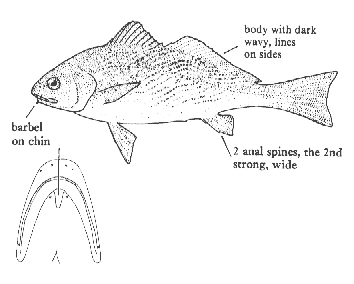
Family: Sciaenidae (Croaker)Genus and Species: Umbrina roncador
Description: The body of the yellowfin croaker is elliptical-elongate with the back somewhat arched. The head is conical and blunt. The color is iridescent blue to gray with brassy reflections on the back diffusing to silvery white below. The sides and back have many diagonal dark wavy lines. The fins are yellowish except for the dark dorsal fins. The yellowfin croaker differs from other California croakers in having a single fleshy projection, a barbel, on the lower jaw and two heavy spines at the front of the anal fin. Maximum length: 21.6 inches.
Range: Yellowfin croakers occur from the Gulf of California, Mexico, to Point Conception, California. They frequent bays, channels, harbors and other nearshore waters over sandy bottoms. These croakers are more abundant along beaches during the summer months and may move to deeper water in winter.
Natural History: The diet of the yellowfin croaker consists mainly of small fishes and fish fry; however, invertebrates such as small crustaceans, worms and mollusks are also eaten in large numbers. Spawning takes place during the summer months when this species is most common along the sandy beaches. Maturity is apparently not reached until the fish are slightly over 9 inches long.
Fishing Information: Yellowfin croaker are most often taken by surf anglers using softshelled sand crabs, worms, mussels, clams or cut fish as bait.Other Common Names: Catalina croaker, yellowtailed croaker, golden croaker.
Largest Recorded: 21.6 inches; no weight reported. However, an 18 inch yellowfin croaker weighed 4.5 pounds.
Habitat: Shallow Sandy Environment
California Corbina
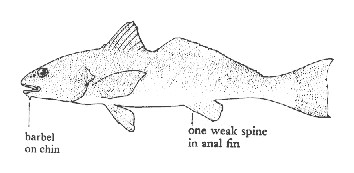
Family: Sciaenidae (Croakers) Genus and Species: Menticirrhus undulatusDescription: The body of the California corbina is elongate and slightly compressed. The head is long and the mouth is small, the upper jaw scarcely reaching a point below the front of the eye. The color is uniform grey with incandescent reflections, and with wavy diagonal lines on the sides. This croaker and the yellowfin croaker are the only two of the eight coastal croakers present in California waters to have a single fleshy projection, or barbel, on the lower jaw. The California corbina usually has only one weak spine at the front of the anal fin, while the yellowfin croaker has two strong spines.
Range: California corbina occur from the Gulf of California, Mexico to Point Conception, California, and is a bottom fish found along sandy beaches and in shallow bays. This species travels in small groups along the surf zone in a few inches of water to depths of 45 feet.
Natural History: Adults have been seen feeding in the surf, at times in water so shallow that their backs were exposed. They scoop up mouthfuls of sand and separate the food by sending the sand through the gills. They are very particular feeders, apparently spitting out bits of clam shells and other foreign matter. About 90 percent of the food they eat is sand crabs. Other crustaceans and clams are of lesser importance. Males mature when 2 years old at a length of about 10 inches and females at age 3 when about 13 inches long. Spawning extends from June to September, but is heaviest during July and August. Spawning apparently takes place offshore as running ripe fish are not often found in the surf zone. The eggs are free floating. Young corbina, 1 inch long, have been observed outside the surf in 4 to 8 feet of water in August.
Fishing Information: California corbina are caught throughout the year along southern California’s sandy beaches, although fishing is at its best from July through September. They are very wary and difficult to hook as many an avid surf fisherman can affirm. Perhaps one reason is that they tend to mouth and chew their food and don’t strike solidly very often. Sand crabs (usually softshells) are the preferred bait, though some anglers swear by blood worms, mussels, clams, pileworms, and ghost shrimp.
Other Common Names: California whiting, surf fish, sucker. California corbina should not be confused with corvina which are taken in the Salton Sea.
Largest Recorded: 28 inches; 8.5 pounds.
Habitat: Surf Environment
White Croaker
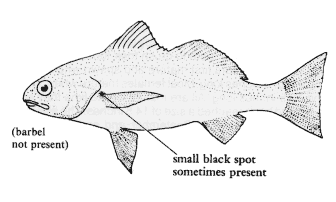
Family: Sciaenidae (Croakers)
Genus and Species: Genyonemus lineatus
Description: The body of the white croaker is elongate and somewhat compressed. The head is oblong and bluntly rounded, with a mouth that is somewhat underneath the head. The color is incandescent brownish to yellowish on the back becoming silvery below. The fins are yellow to white. The white croaker is one of five California croakers that have mouths located under their heads (subterminal). They can be distinguished from the California corbina and yellowfin croaker by the absence of a single fleshy projection, or barbel, at the tip of the lower jaw. The 12 to 15 spines in the first dorsal fin serve to distinguish white croakers from all the other croakers with sub- terminal mouths, since none of these has more than 11 spines in this fin.
Range: White croakers have been taken from Magdalena Bay, Baja California, to Vancouver Island, British Columbia, but are not abundant north of San Francisco. White croakers swim in loose schools at or near the bottom of sandy areas. Sometimes they aggregate in the surf zone or in shallow bays and lagoons. Most of the time they are found in offshore areas at depths of 10 to 100 feet. On rare occasions they are fairly abundant at depths as great as 600 feet.
Natural History: White croakers eat a variety of fishes, squid, shrimp, octopus, worms, small crabs, clams and other items, either living or dead. While the ages of white croakers have not been determined conclusively, it is thought that some live as long as 15 or more years. Some spawn for the first time when they are between 2 and 3 years old. At this age they are only 5 to 6 inches long and weigh less than 0.10 pounds.
Fishing Information: These fish can be caught on almost any kind of animal bait that is fished from piers or jetties in sandy or sandy mud areas. In fact, they are so easily hooked that most anglers consider them a nuisance of the worst sort. If a person desires to fish specifically for white croakers a tough, difficult-to- steal bait, such as squid, is recommended. When hooked, they put up little or no fight. Fishing and catching is good throughout the year.
Other Common Names: kingfish, shiner, Pasadena trout, tommy croaker, little bass.
Largest Recorded: 17 inches; no weight recorded. However, a 14.5 inch white croaker weighted 1.41 pounds.
Habitat: Shallow Sandy Environment
Spotfin Croaker
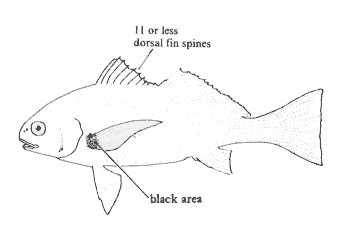
Family: Sciaenidae (Croakers)
Genus and Species: Roncador stearnsii
Description: The body of the spotfin croaker is elongate, but heavy forward. The upper profile of the head is steep and slightly curved, and abruptly rounded at the very blunt snout. The mouth is underneath the head (subterminal). The color is silvery gray with bluish luster above and white below. There are dark wavy lines on the side, and a large black spot at the base of the pectoral fin. The subterminal mouth, absence of a fleshy barbel and the large black spot at the base of the pectoral fin distinguish spotfin croakers from all other California croakers. Small “spotties” are sometimes confused with small white croakers, but a count of the dorsal fin spines will quickly separate them; the spotfin croaker has 11 or fewer (usually 10), while the white croaker as 12 to 15. So-called “golden croakers” are nothing more than large male spotfin croakers in breeding colors.
Range: Spotfin croakers occur from Mazatlan, Mexico, to Point Conception, California, including the Gulf of California. In California, they are most commonly found south of Los Angeles Harbor. They live along beaches and in bays over bottoms varying from coarse sand to heavy mud and at depths varying from 4 to 50 feet or more. They prefer depressions and holes near shore.
Natural History: Spotfin croakers eat a wide variety of food items. Apparently they prefer clams and worms. Small crustaceans are also eaten extensively. They use the large pavement- like pharyngeal (throat) teeth to crush their food. Male spotfin croakers first mature and spawn when 2 years old and about 9 inches long. Most females mature when 3 years old and 12.5 inches long. All are mature by the time they are 4 years old and have reached a size of 14.5 inches. The spawning season runs from June to September and apparently takes place offshore, since no ripe fish have been caught in the surf zone. One inch juveniles do appear in the surf in the fall. Spotfin croaker travel considerably, but with no definite pat- tern. They move extensively from bay to bay. For example, fish tagged in the Los Angeles Harbor were later taken as far south as Oceanside. Spotfin tagged in Newport Bay moved to Alamitos Bay and vice versa.
Fishing Information: Although some are caught throughout the year, late summer is best for spotfin croaker fishing. Good fishing seems to depend on runs. When a “croaker hole” is found and a run is on, good fishing can be had by all present whether in a bay, from a pier or in the surf. Most spotfin croaker caught are small to medium sized fish.
Other Common Names: spotties, spot, golden croaker.
Largest Recorded: 27 inches. Largest taken off California by a recreational angler: 14.0 pounds in 1951.
Habitat: Shallow Sandy Environment
California Marine Sportfish Identification: Surfperch
Last Updated October 17, 2013
Note: Please consult current fishing regulations for species presented in this booklet. To view information on safe fishing eating guidelines, please visit the OEHHA website.
Barred Surfperch | Redtail | Rubberlip | Shiner | Silver | Walleye
Silver Surfperch
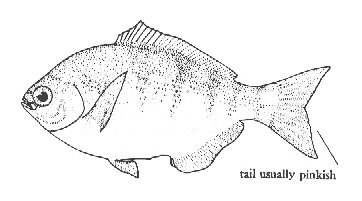
Family: Embiotocidae (Surfperches)
Genus and Species: Hyperprosopon ellipticum
Description: The body of the silver surfperch is oval and strongly compressed. The head is small and the mouth is moderately large. The body is silvery with dusky (brownish to gray) coloration on the back and dusky bars on the sides. The tail is usually pink with an occasional orange spot on the anal fin. The specific name ellipticum refers to its elliptical body out- line. It looks similar to the walleye surfperch but lacks the silver coloration on its pelvic fins.
Range: Silver surfperch occur from Rio San Vicente, Baja California, to Schooner Cove, near Tofino, Vancouver Island, British Columbia. These small surfperch primarily frequent the sandy surf zone although they are also caught among shallow rocks from piers, and in bays.
Natural History: The diet of silver surfperch includes shrimp, crustaceans, amphipods and algae. As with all surfperch, the young are born alive and are relatively large. Mating occurs during the fall and early winter months. The male approaches the female from below; both swim with vents close for 2 or 3 seconds, then separate and repeat the process. Three to 17 young are born the following spring and summer.
Fishing Information: Silver surfperch rank among the top ten in numbers caught by recreational anglers in central and northern California, even though the average weight is 0.1 pound. They are plentiful, easy to catch and occur in large numbers in surf, shore and pier catches.
Other Common Names: silver perch, shiner.
Largest Recorded: 10.5 inches; no weight recorded.
Habitat: Shallow Sandy Environment
Walleye Surfperch
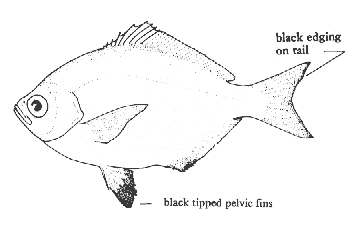
Family: Embiotocidae (Surfperches)
Genus and Species: Hyperprosopon argenteum
Description: The body of the walleye surfperch is oval and strongly compressed. The head is small and the eyes are large. The mouth is small and slanted downward. The color is silver with faint dusky shading on the back. The tips of the ventral fins are black as are the borders of the anal fin and tail. The walleye surfperch can be distinguished from other surf- perch by the distinctive black tips on the ventral fins and black borders on the tail and anal fins.
Range: Walleye surfperch occur from Point San Rosarito, Baja California, to Vancouver Island, British Columbia. This species is found in dense schools along sandy beaches, near rocks and around piers. They appear to move into embayments such as Humboldt Bay during summer.
Natural History: Walleye surfperch feed primarily on small crustaceans. Mating takes place in October, November and December when the usual dense schools break up and the males and females pair off. The encroachment of another male is immediately countered by a quick charge from the courting male toward the intruder’s snout. Between 1 and 19 young, depending on the size of the mother, are born the following spring. They average a little over 1.5 inches in length at birth. They reach maturity the following fall and winter; in fact, the largest proportion of the breeding population appears to be young of the year. Walleyes are probably short-lived as are most other surfperches. A 10.5 inch walleye was only 6 years old.
Fishing Information: Walleyes can be caught in the surf, from rocks, and from piers anywhere along the open coast. They usually are the most abundant surfperch caught from piers. A small hook baited with mussels, pieces of fish, worms, squid or shrimp will catch walleyes any season of the year. Often occurring in dense schools 6 to 8 feet thick, comprised of several hundred fish, the walleye can provide very rewarding fishing.
Other Common Names: walleye surf fish, walleye seaperch, china pompano, white perch.
Largest Recorded: 12 inches
Habitat: Bay Environment
Shiner Surfperch
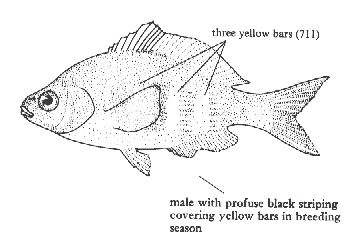
Family: Embiotocidae (Surfperches)
Genus and Species: Cymatogaster aggregata
Description: The body of the shiner surfperch is elongate oval and compressed. The head is short and the mouth is small. The body is gray to greenish above with vertical lemon yellow cross bars in the shape of a “711” and eight horizontal sooty lines along the sides. During courtship and breeding the males are dark gray, almost black, in color and have a black spot on each side of the snout.
Range: Shiner surfperch occur from San Quintin Bay, Baja California, to Port Wrangell, Alaska. They prefer calm water and are most abundant in bays around eelgrass beds and the pilings of wharfs and piers. They have been captured in trawl nets fishing in 350 to 480 feet of water and have been observed by divers at depths as great as 120 feet, but are more numerous in shallow inshore waters.
Natural History: The diet of shiner surfperch consists mostly of small crustaceans and other invertebrates. They are frequently observed around pier pilings nipping off the appendages of barnacles. Mating takes place during the summer months in most localities, and the young are born the following spring and summer. During courtship, the male closely follows the female, their movements remarkably well synchronized. He will leave her side frequently to chase off other fish, many of which are not the least bit attracted to his mate. They are apparently short-lived as a 6 inch female (large for shiner surfperch) was only 3 years old.
Fishing Information: Shiner surfperch are caught from shore, docks, piers, rocks, and almost any other fishing area. They are probably the number one fish caught by youngsters along the California coast. They can be taken on almost any type of bait and any type of fishing equipment from handline to spinning gear so long as the hook on the end of the line is small enough for the fish to get in their mouths.
Other Common Names: shiner perch, shiner, shiner seaperch, yellow shiner, bay perch, seven-eleven perch.
Largest Recorded: 7 inches, reported to 8 inches; no weight recorded; however, a pregnant female 6.75 inches long weighed just under 3 ounces.
Habitat: Bay Environment
Redtail Surfperch
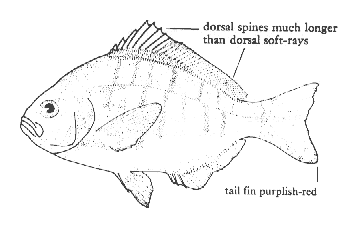
Family: Embiotocidae (Surfperches)
Genus and Species: Amphistichus rhodoterus
Description: The body of the redtail surfperch is oval and compressed. The upper profile of the head is nearly straight from the snout to the dorsal fin except for a slight depression above the eye. The body color is silver with olive green mottling and bars on the side. The tail is pink to deep purple. This species can be separated from the other two species that live off sandy beaches and have similar color markings (barred and calico surfperch) by the red to deep purple tail and the spines in the dorsal fin, which are longer than the soft rays.
Range: The redtail surfperch occurs from Avila Beach, California, to Vancouver Island, British Columbia, and is the most often encountered surfperch from San Francisco northward. Redtail surfperch are predominantly surf dwellers off sandy beaches, but have been taken in rocky areas adjacent to beaches. They are common in estuaries and protected embayments during the spawning season.
Natural History: Small crustaceans are the major food items preferred by this species; however, small crabs, shrimp, mussels or marine worms are also attractive to redtail surfperch. Like all surfperch, the redtail gives birth to live young. The young are carried inside the mother until birth when they emerge as miniature replicas of the adults. Males mature at age 2 and females at age 4. They breed in fall and give birth in spring and summer, primarily from June to August. Females contain up to 51 young with the average of 27.
Fishing Information: Redtail surfperch concentrate just before spawning in sheltered inshore waters during the spring and early summer. They are frequently caught in large numbers at this time. The average size of redtail surfperch that an angler usually catches is 1.8 pounds, although 3 pound fish are not uncommon. Light tackle and crab backs for bait is the preferred method of take in Humboldt Bay. For surf fishing, sand crabs, tube worms or clams can be used for bait.
Other Common Names: rosy surf fish, redtail seaperch, porgie, Oregon porgie.
Largest Recorded: 16 inches; no weight recorded. Largest taken off California by a recreational angler: 3 pounds, 4 ounces.
Habitat: Surf Environment
Rubberlip Surfperch
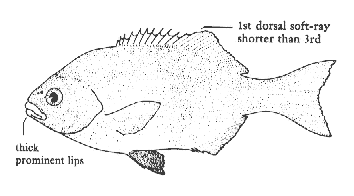
Family: Embiotocidae (Surfperches)
Genus and Species: Rhacochilus toxotes
Description: The body of the rubberlip surfperch is oval and compressed. The mouth is comparatively large and the lips are extremely thick. The lower jaw is slightly shorter than the upper. The color is variable but it is generally whitish with brown to brassy overtones on the back fading to tan below. The lips are whitish or pink. Juveniles have one or two vertical dusky bars on the body, although these usually are not found on adults. Its large size and thick prominent lips distinguish it from all other surfperches.
Range: Rubberlip surfperch occur from Thurloe Head, Baja California, to Russian Gulch State Beach, California. They frequent rocky areas, tidepools and kelp beds on the outer coast as well as bays and harbors.
Natural History: Adults feed upon crabs, shrimps and octopus. Juveniles feed on typical surfperch food such as worms, small crabs, mussels, and tiny snails. Like all surfperch, the rubberlip surfperch bears its young live. A 16.5 inch female, that was 8 years old and weighed slightly less than 3 pounds contained 21 young that averaged a little over 3.5 inches in length.
Fishing Information: Recreational anglers catch rubberlip surfperch from skiffs, piers and the shore. The greatest number have been taken from piers in the Monterey Bay area, with the average size caught by sport anglers being 2 pounds. Most hook-and-line catches are made using mussels, clams, sand worms, cut shrimp or similar bait.
Other Common Names: pile perch, rubberlip seaperch, porgee, sprat, liverlip, buttermouth.
Largest Recorded: 19.6 inches; no weight recorded; however, a 16.5 inch rubberlip surfperch weighed nearly 3 pounds.
Habitat: Shallow Sandy Environment
Barred Surfperch
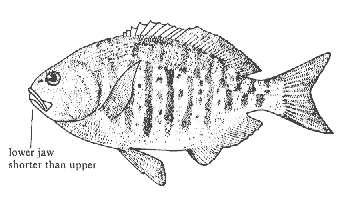
Family: Embiotocidae (Surfperches)
Genus and Species: Amphistichus argenteus
Description: The body of the barred surfperch is oval and compressed. The head is blunt and the mouth is comparatively large. The color is olive green to yellow green on the back becoming silver below; with bronze, brassy or yellow vertical bars and spots on the side. This surfperch is one of three living off sandy beaches with similar color markings; however, it can be distinguished from the other two (calico and redtail) by its lower jaw being slightly shorter than the upper, and by the absence of red or reddish color on its fins.
Range: The barred surfperch occurs from Plaza Maria Bay, Baja California, to Bodega Bay, California. It is more abundant than the calico and redtail south of Cayucos, California. Barred surfperch are found in the surf zone along sandy beaches where they seem to congregate in depressions on the bottom. They have been taken from water as deep as 240 feet.
Natural History: The major portion of the barred surfperch diet is sand crabs, with other crustaceans, bean clams and small crabs comprising the remainder. Barred surfperch give birth to living young from March to July. As few as four and as many as 113 have been counted, but the average is 33 per female. They are about 2.5 inches long at birth, and mature when about 6.5 inches long and 1 or 2 years old. This species is relatively short lived with the oldest males being about 6 years old and 12 inches long. The oldest females are about 9 years old and up to 17 inches long. Tagging studies indicate barred surfperch move very little, usually less than 2 miles, although movements up to 31 miles have been recorded.
Fishing Information: The most popular bait for barred surfperch is soft shelled sand crabs, but blood worms, mussels, cut fish, and small artificial lures also work. Fishing is usually best on an incoming tide when the perch are feeding inside the breaker zone.
Other Common Names: barred perch, silver perch, surf perch, sand perch, silver surf fish.
Largest Recorded: 17 inches; 4.5 pounds.
Habitat: Surf Environment
California Marine Sportfish Identification: Tuna & Mackerels
Last Updated June 26, 2015
Note: Please consult current fishing regulations for species presented in this booklet. To view information on safe fishing eating guidelines, please visit the OEHHA website.
Albacore | Bigeye Tuna | Bluefin Tuna | Pacific Bonito | Pacific Mackerel | Skipjack | Yellowfin Tuna
Pacific Mackerel
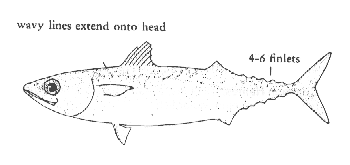
Family: Scombridae (Mackerels and Tunas)
Genus and Species: Scomber japonicus
Description: The body of the Pacific mackerel tapers at both ends, is rather elongate, and somewhat compressed. The head is pointed and the mouth is large. The head is dark blue, the back is dark blue with about 30 dark wavy lines, and the undersides are silver green. The widely separated first and second dorsal fins serve to distinguish Pacific mackerel from all of the other tuna-like fishes that inhabit our waters, except for the frigate and bullet mackerel. Pacific mackerel and bullet mackerel can be differentiated by counting the dorsal finlets. Pacific mackerel typically have four to six, while bullet and frigate mackerel have seven to eight finlets.
Range: Worldwide in temperate seas; in the eastern Pacific from Chile to the Gulf of Alaska.
Natural History: Larval, juvenile or small fishes appear to be the most important natural food of Pacific mackerel, but there are times when they rely heavily on small crustaceans. They feed upon squid to a lesser extent, and eat whatever other bite-sized organisms they may encounter. Off southern California, spawning normally reaches a peak during the early spring months, especially March, April and May. Pacific mackerel eggs are about 0.045 inch in diameter and float free in the upper layers of the ocean, usually within 300 feet of the surface. At average water temperatures they will hatch 4 or 5 days after being spawned.
Fishing Information: Pacific mackerel have long been cast in the role of an intruder or nuisance fish by most anglers, especially those seeking larger sportfish like yellowtail or barracuda. Nevertheless, they have been the most frequently caught species on hook and line in California waters in recent years. Known as a voracious, indiscriminant feeder, Pacific mackerel will devour a live anchovy, engulf dead cut bait, strike readily on lures and often on flies. While it is relatively small in size (2 pounds or 16 inches would be trophy size), it scores high for power (ounce for ounce) and beauty. Pacific mackerel put up an excellent fight against light tackle.
Other Common Names: American mackerel, blue mackerel, greenback jack, chub mackerel.
Largest Recorded: 25 inches; 6.3 pounds.
Habitat: Pelagic Environment
Skipjack
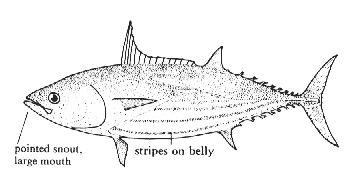
Family: Scombridae (Mackerels and Tunas)
Genus and Species: Euthynnus pelamis
Description: The body of the skipjack is cigar-shaped (tapers at both ends). The snout is sharply pointed and the mouth is relatively large. The color is dark blue to purple on the back become silvery or white below, with four to six dark horizontal stripes on the belly.
Range: Skipjack occur worldwide in warm seas. They are found in the eastern Pacific from Peru to Vancouver Island, British Columbia. Skipjack usually visit California waters in the fall when water is relatively warm (about 68° F) and the currents are from either the south or southwest.
Natural History: The diet of the skipjack tuna includes fishes such as anchovies and sardines, as well as pelagic red crabs and squid. Skipjack tuna do not spawn in waters off California, but further south in the eastern Pacific, with spawning occurring during the summer months. Females mature at about 16 inches. Depending on size, females can produce between 100,000 and 2 million eggs per spawning event. Young fish grow rapidly reaching 12 inches by the time they are 1 year old. Maximum age is estimated to be 8 to 12 years.
Fishing Information: Most skipjack are taken incidentally to other fishing activities, especially albacore or tuna fishing. They bite a feather eagerly and will readily come to the boat when live anchovies are used as chum. Most anglers do not actively seek skipjack because of their small size and the undesirability of the meat when fresh. However, skipjack is good if processed and most is consumed after it is canned. Most skipjack taken off California weigh 3.5 – 6.5 pounds, and are 18 to 22 inches.
Other Common Names: skippies, oceanic bonito, striped tuna, arctic bonito, watermelon, victor fish.
Largest Recorded: The maximum reported length of a skipjack tuna is about 3.7 feet; the maximum weight is about 74 pounds. In California, the angling record stands at 26 pounds (no length).
Habitat: Pelagic Environment
Pacific Bonito
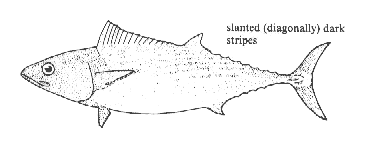
Family: Scombridae (Mackerel and Tunas)
Genus and Species: Sarda chiliensis
Description: The body of the Pacific bonito is cigar-shaped and somewhat compressed. The head is pointed and conical, and the mouth is large. The color is dark blue above, dusky on the sides becoming silvery below. There is a number of slanted darkish stripes along the back. Pacific bonito are the only tuna-like fishes on the California coast that have the slanted dark stripes on their backs.
Range: Pacific bonito occur discontinuously from Chile to the Gulf of Alaska, with the greatest area of abundance in the northern hemisphere occurring in warm waters between Magdalena Bay, Baja California, and Point Conception, California.
Natural History: The preferred food of bonito appears to be small fishes, such as anchovies and sardines. Occasionally, they rely heavily upon squid in their daily diet. Bonito may not spawn successfully every year in California, but successful spawning does take place further south each year. The bulk of southern California spawning appears to take place from late January through May. The free floating eggs require about 3 days to hatch at average spring water temperatures. Young fish resulting from local successful spawnings are usually first observed by the various live bait haulers when they are 6 to 10 inches long in the early summer months. These fish will often weigh 3 pounds or more by the fall of the year and by May of the following year many will weigh 6 or 7 pounds.
Fishing Information: Pacific bonito are excellent fighters and have hearty appetites. Once a school is aroused they will take almost any bait or lure that is tossed their way. Most Pacific bonito are taken by a combination of trolling and live bait fishing. The schools are located by trolling feathers, and live anchovies or squid pieces are used to bait the fish once located. Fishing for bonito generally takes place offshore in 300 to 600 feet of water, but may occur next to kelp beds when the fish are near shore. Pacific bonito may arrive off of California as the ocean warms in the spring, but may never show up if oceanic conditions dictate colder than normal water temperatures. Bonito anglers generally catch 1 to 4 year old fish, weighing between 3 and 12 pounds. Pacific bonito fishing tapers off in the fall as the water cools, but persistent anglers still find good bonito fishing around warm water outfalls associated with power plants.
Other Common Names: bonehead, Laguna tuna, magneto, striped tuna, California bonito, ocean bonito.
Largest Recorded: 40 inches; 25 pounds.
Habitat: Pelagic Environment
Albacore
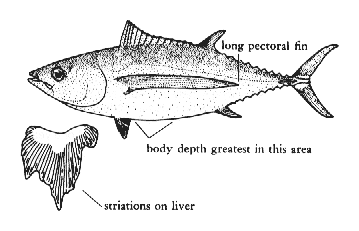
Family: Scombridae (Mackerels and Tunas)
Genus and Species: Thunnus alalunga
Description: The body of the albacore tapers at both ends (cigar-shaped). The head is long and the mouth fairly large. The color is dark gray to metallic blue on the back becoming white to gray below. Albacore are easily distinguished from the other tunas occurring off California, with exception of the bigeye, by the extreme length of their pectoral fins (they extend well past the anal fin). Albacore and bigeye can best be distinguished by the characteristics of their livers. The albacore has a heavily striated (covered with blood vessels) liver while the liver of the bigeye is only lightly striated along the edges.
Range: Albacore occur worldwide in temperate seas; in the eastern Pacific they range from south of Guadalupe Island, Baja California, to southeast Alaska.
Natural History: The food of the albacore varies, depending upon where they are feeding in the water column and what items are available at the time and place the albacore are feeding. A majority of the food consists of small fishes, but at times squid, octopus, shrimp-like and crab-like organisms are extremely important. There are indications that albacore spawning takes place in the mid-Pacific, probably north and west of the Hawaiian Islands. Large specimens caught in that area during late summer on long line gear have had nearly ripe eggs in their ovaries. The albacore is one of the world’s fastest migrant fish. Annual trans-Pacific migrations have been documented by tagging. Fish tagged off California were captured off Japan, nearly 5,000 miles away, 294 days later. Traveling “as the crow flies”, this is equivalent to more than 17 miles a day.
Fishing Information: Albacore are the most sought after of the tunas by California anglers. Most fishing for albacore takes place 20-100 miles offshore in central and southern California. They are rarely taken near shore. Albacore have a preference for deep blue oceanic water and mild temperatures. Studies indicate that 57 of every 100 albacore caught are hooked in water ranging in temperature between 60° and 64° F. Albacore travel in loosely knit schools which are located by trolling or observing surface signs (feeding birds, etc.). Once located, they are fished with hook and line using live anchovies for bait. They may also be caught on a trolled feathered jig.
Other Common Names: longfin, albie, pigfish, Pacific albacore, German.
Largest Recorded: 5 feet; 90 pounds (California).
Habitat: Pelagic Environment
Bigeye Tuna

Family: Scombridae (Mackerels and Tunas)
Genus and Species: Thunnus obesus
Description: The body of the bigeye tuna is cigar-shaped (tapered at both ends). The head is pointed and the eye is relatively large. The color is dark metallic brownish blue to dark yellow on the back becoming gray or whitish below. There often is a bluish stripe on the side. In most individuals, the length of the pectoral fins should enable one to identify the species properly. Both bigeye and yellowfin tuna look similar, but bigeye tuna have pectoral fins which extend well past their anal fin, while yellowfin tuna have much shorter pectoral fins. Tuna which cannot be distinguished by external characteristics can be positively identified by liver characteristics. Bigeye tuna livers are striated (covered with blood vessels) along the trailing edges, while yellowfin tuna livers are smooth. Small bigeye tuna also may be distinguished from albacore by the characteristics of the liver. The liver is heavily striated in the albacore while the bigeye tuna liver is only striated along the trailing edges.
Range: Bigeye tuna occur worldwide in warmer seas. In the eastern Pacific these tuna range from Peru to Iron Springs, Washington. They are occasional visitors to California, entering our fishing grounds in June and remaining until November. These fish prefer temperate water in excess of 70° F, but significant catches have occurred in water as cool as 65° F.
Natural History: The diet of bigeye tuna includes fishes, squid, and crustaceans. Like most other tunas, they feed on what is most abundant in the area. Bigeye tuna do not spawn in waters off California, but spawn further south in the Pacific. Bigeye tuna are approximately 3 years old at first spawning. In the equatorial regions of the Pacific, the peak spawning is between April and September. A bigeye tuna weighing 159 pounds will produce an estimated 3.3 million eggs per year. The young are fast growing and weigh about 45 pounds when they first mature. They live 7 or 8 years.
Fishing Information: Bigeye tuna generally are not accessible to recreational anglers because they travel far below the surface during the day. Only rarely are they seen on the surface, and then, only momentarily while feeding. This makes the fish hard to locate since they leave no telltale surface signs nor can they be easily located by trolling. Most bigeye tuna are taken incidental to albacore or marlin fishing. The best way to fish for them is to troll marlin lures in an area where the fish are known to occur. Most bigeye tuna taken in southern California weigh 50 to 100 pounds, with an occasional 150 to 200 pounder landed.
Other Common Names: gorilla, tuna, patudo.
Largest Recorded: 80 inches; 435 pounds; 240 pounds (California).
Habitat: Pelagic Environment
Bluefin Tuna
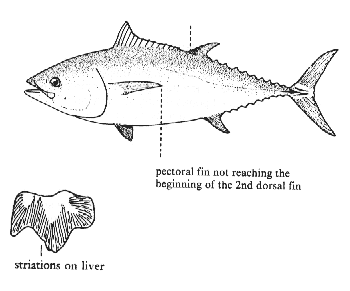
Family: Scombridae (Mackerel and Tunas)
Genus and Species: Thunnus orientalis
Note: Note: It was determined in 1997 that Atlantic (Thunnus thynnus) and Pacific populations are separate species.
Description: The body of the bluefin tuna is cigar-shaped and robust. The head is conical and the mouth rather large. The color is dark blue above and gray below. Bluefin tuna can easily be distinguished from other members of the tuna family by the relatively short length of their pectoral fins. Their livers have a unique and definitive characteristic in that they are covered with blood vessels (striated). In other tunas with short pectoral fins, such vessels are either not present or present in small numbers along the edges.
Range: Worldwide in all but the coldest seas. Bluefin tuna range throughout the eastern North Pacific Ocean with fish being taken from Magdalena Bay, Baja California, to Shelikof Strait, Alaska. Most bluefin tuna landed by California anglers are 1 or 2 year olds and weigh between 15 and 30 pounds.
Natural History: Examination of a number of stomachs indicates that while in California waters anchovies make up the bulk of the diet. Sanddabs, surfperches, and white croakers are also consumed.
Fishing Information: Bluefin tuna are seasonal visitors to California waters. They usually appear in May and depart by October. Since they are temperate tunas, their availability to anglers depends on water temperatures in the 62° to 68° F degree range. They can be located by either trolling feathers or anchoring at a spot known to be frequented by bluefin tuna, and chumming with live anchovies.
Other Common Names: leaping tuna, tuna, footballs, tunny, shortfin tuna, ahi, great albacore.
Largest Recorded: No length recorded; 363.5 pounds (California). Weight to 495 pounds in the Pacific Ocean, and 1,500 pounds in the Atlantic Ocean.
Habitat: Pelagic Environment
Yellowfin Tuna
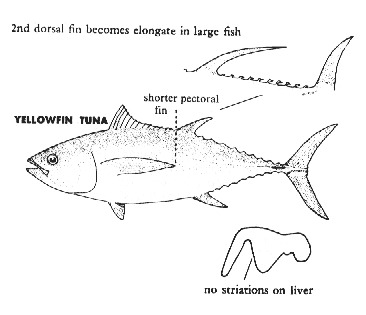
Family: Scombridae (Mackerel and Tunas)
Genus and Species: Thunnus albacares
Description: The body of the yellowfin tuna tapers at both ends (cigar-shaped), and the head is conical. The color is dark brownish blue to dark yellow on the back becoming gray or whitish below. Identifying tunas can be difficult, especially when yellowfin and bigeye tuna are involved. In most cases, the length of the pectoral fins can distinguish each species. The yellowfin has pectoral fins which do not extend past the anal fin; while in bigeye, the pectoral fins extend well past the anal fin. Tuna which cannot be distinguished by external characteristics can be positively identified by liver characteristics. The surface of a yellowfin’s liver is smooth while the liver of the bigeye is striated, containing many with small blood vessels along the trailing edge.
Range: Widely distributed in the Pacific Ocean. In the eastern Pacific, yellowfin tuna occur from Chile to Point Buchon, California. They occasionally enter California waters when ocean temperatures are warm. They usually are not taken in waters less than 70° F with best catches occurring in waters above 74° F.
Natural History: The diet of the yellowfin tuna includes juvenile fishes, crustaceans, and squid. They are opportunistic feeders taking whatever is most available in the area. Yellowfin tuna do not spawn off the coast of California; however, they do spawn further south in the eastern Pacific. Some spawning takes place during every month of the year, but off Central America it peaks during January and February. Young fish grow very rapidly and by the time they are 1.5 years old they weigh around 7.5 pounds. At 4 years old they weigh approximately 150 pounds. The largest yellowfin tuna taken are 10 or more years old. These larger fish sometimes have an elongated second dorsal fin.
Fishing Information: Yellowfin tuna are fished in much the same manner as albacore; jigs are used to locate the schools, and live anchovies are chummed to keep the fish around the boat. Most yellowfin tuna taken in California weigh 30 to 50 pounds, fish over 200 pounds are occasionally landed. The smaller fish are 1 to 2 years old while the larger ones may be over 10 years of age.
Other Common Names: Allison tuna, ahi, Pacific yellowfin.
Largest Recorded: No length recorded; 239 pounds (California); weight to 450 pounds.
Habitat: Pelagic Environment
 Save Newport Real News in Newport Beach
Save Newport Real News in Newport Beach












